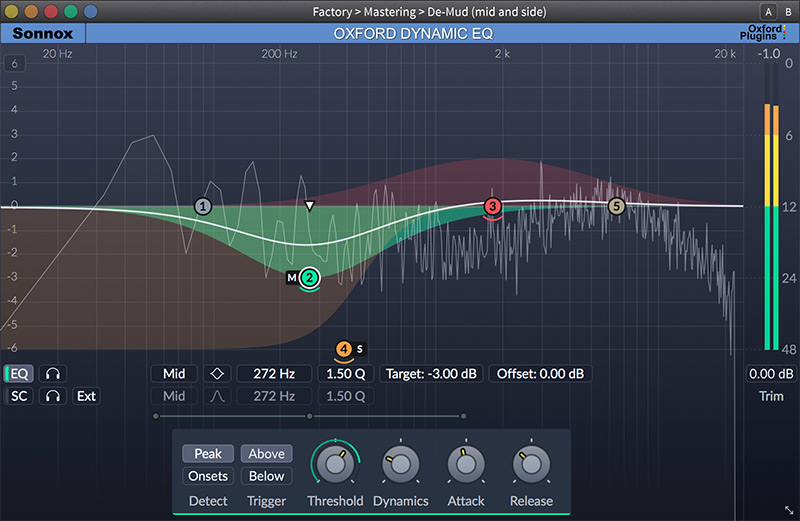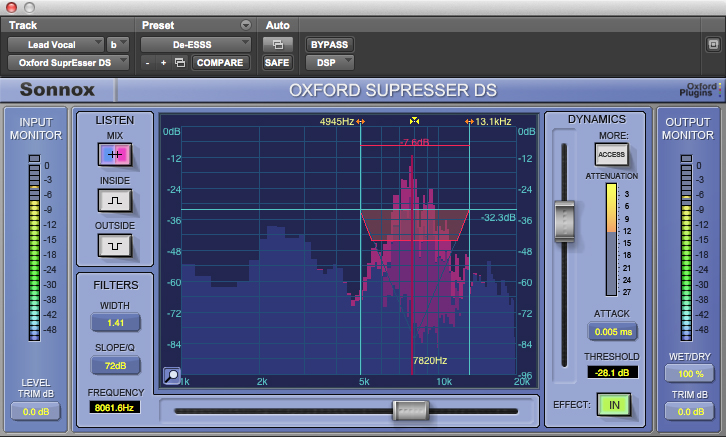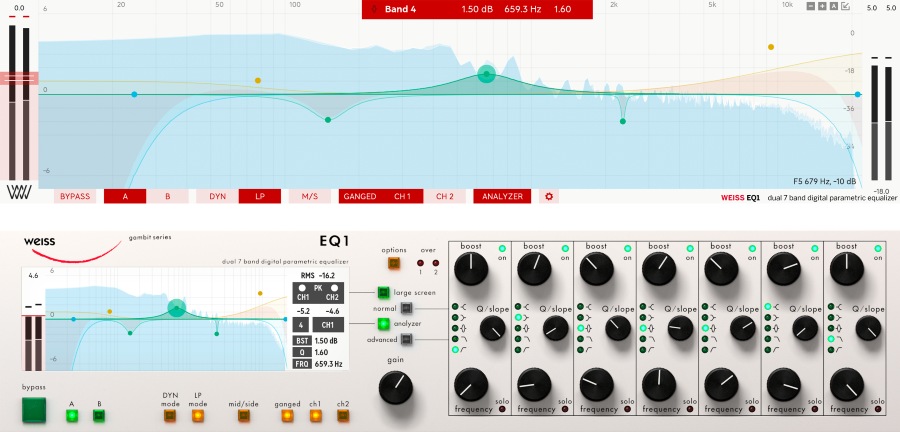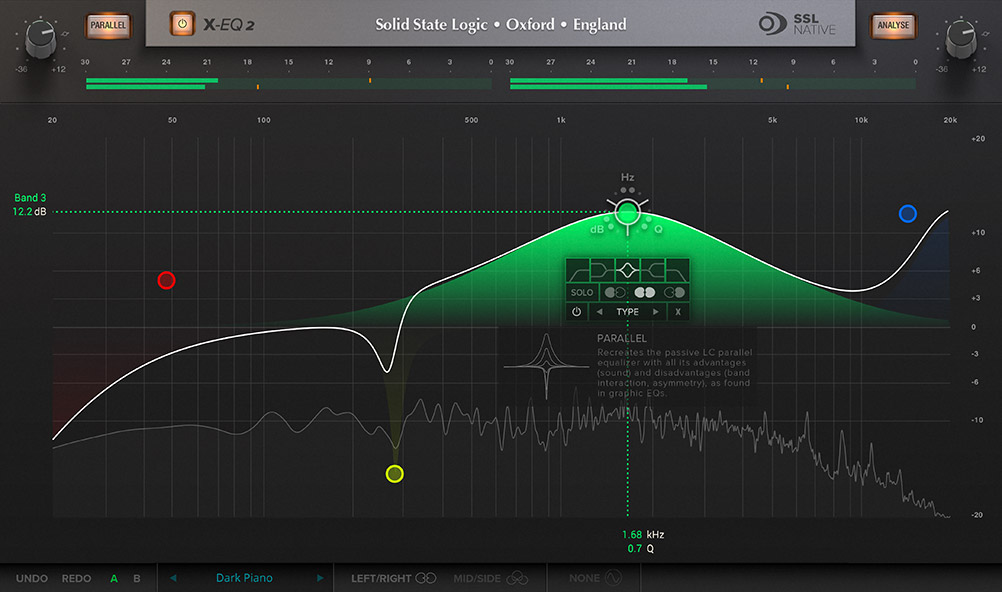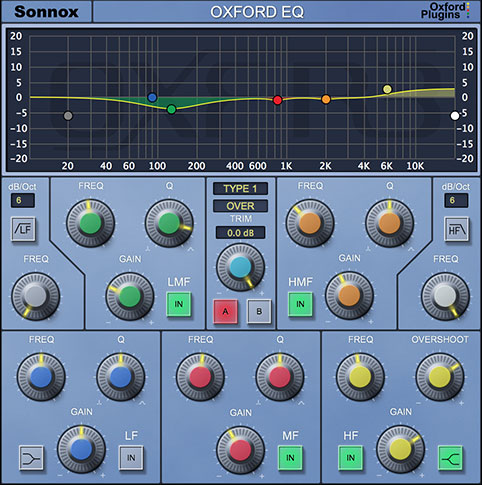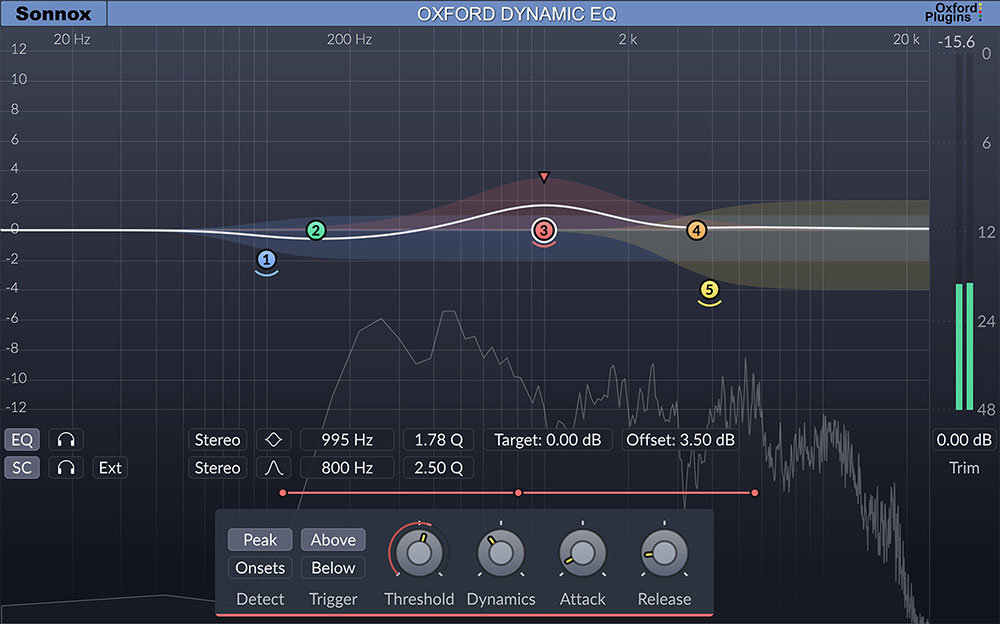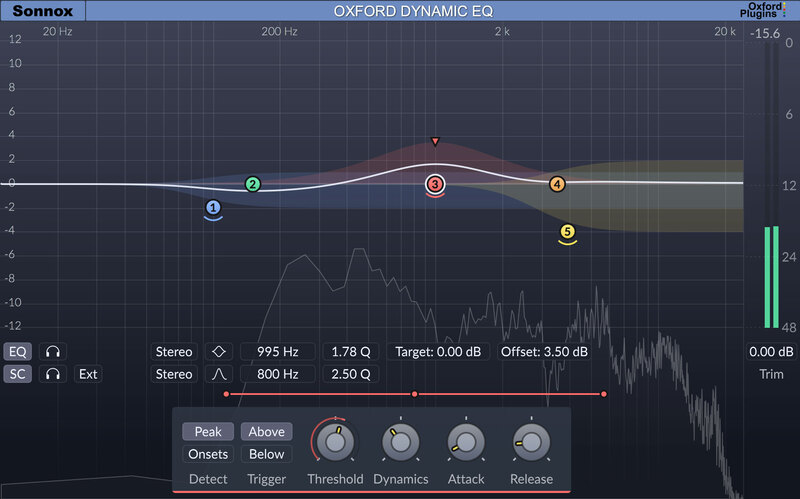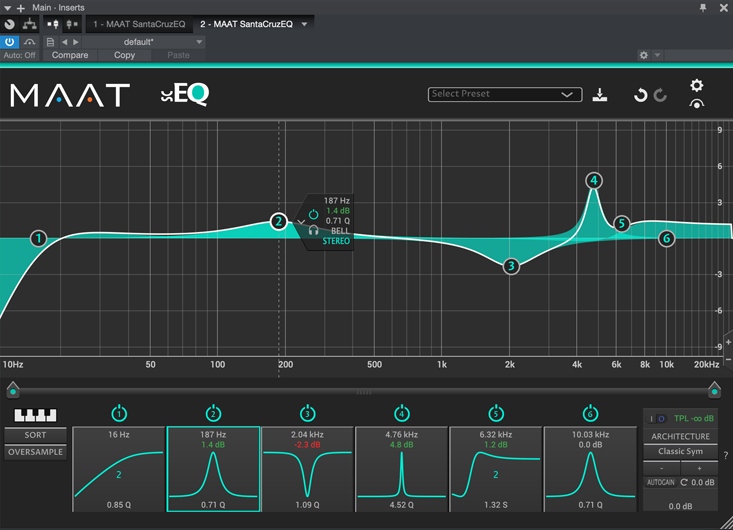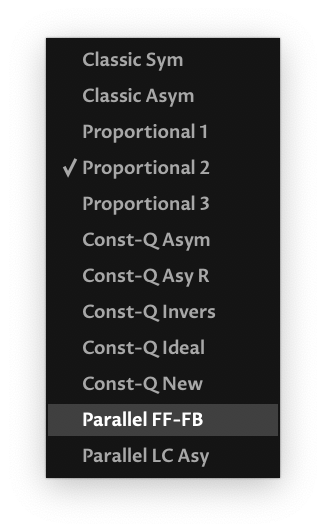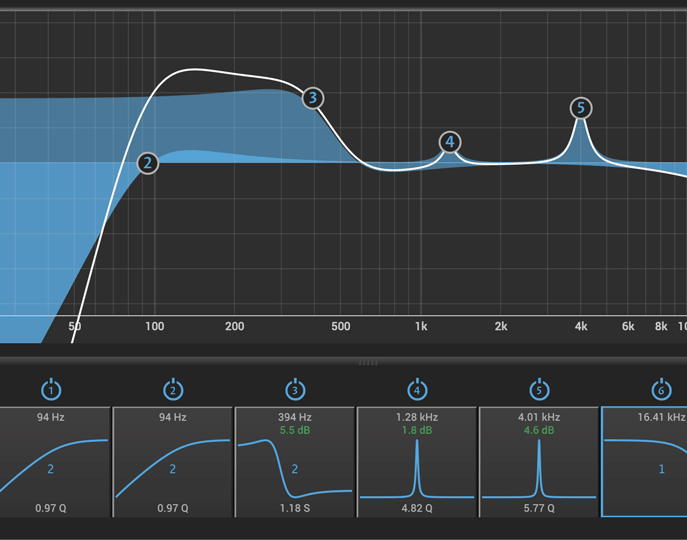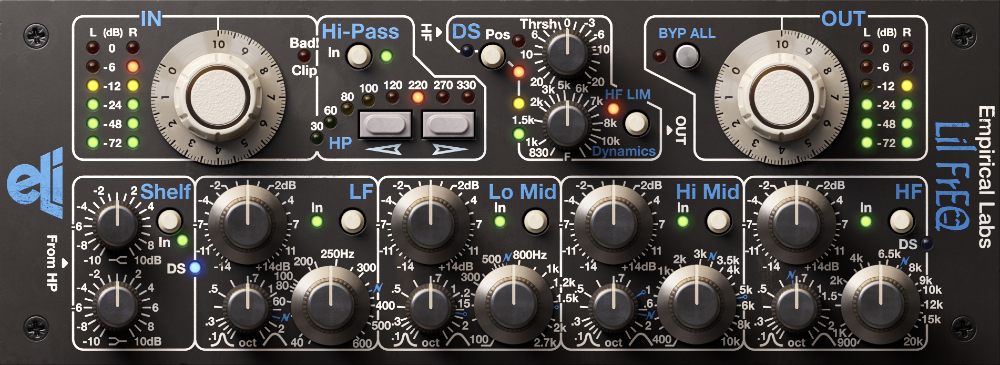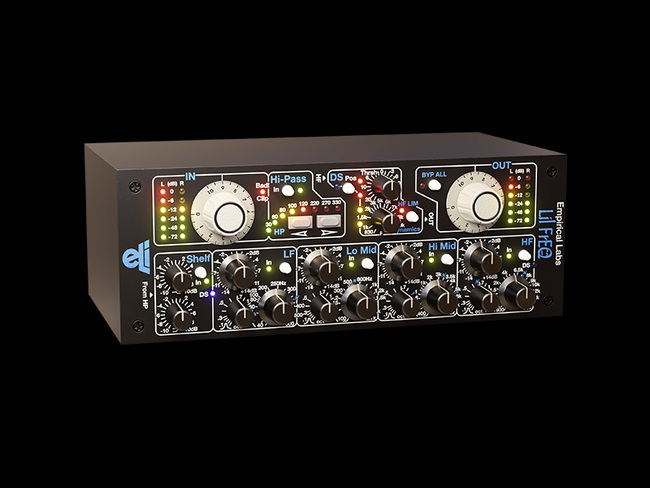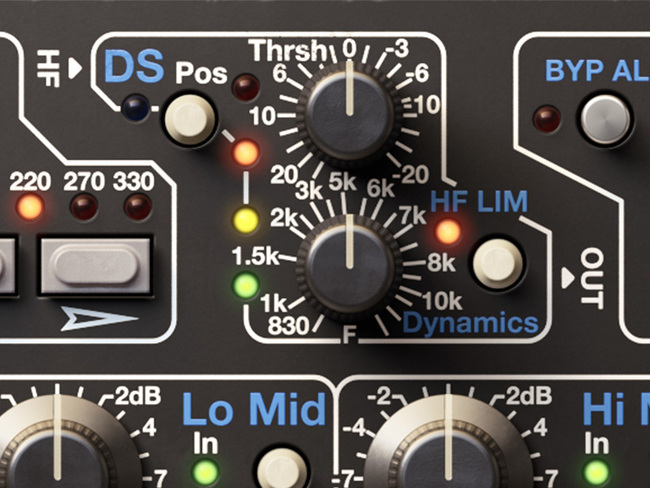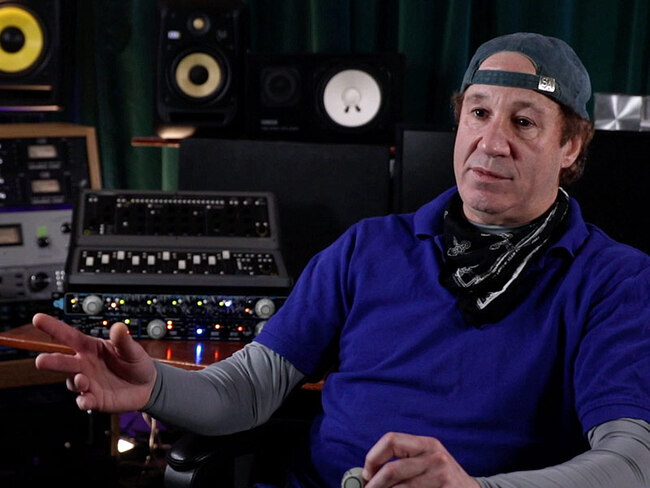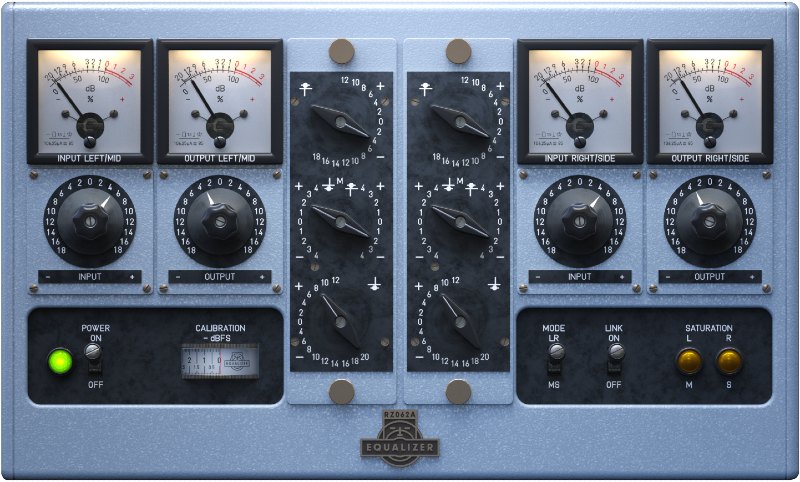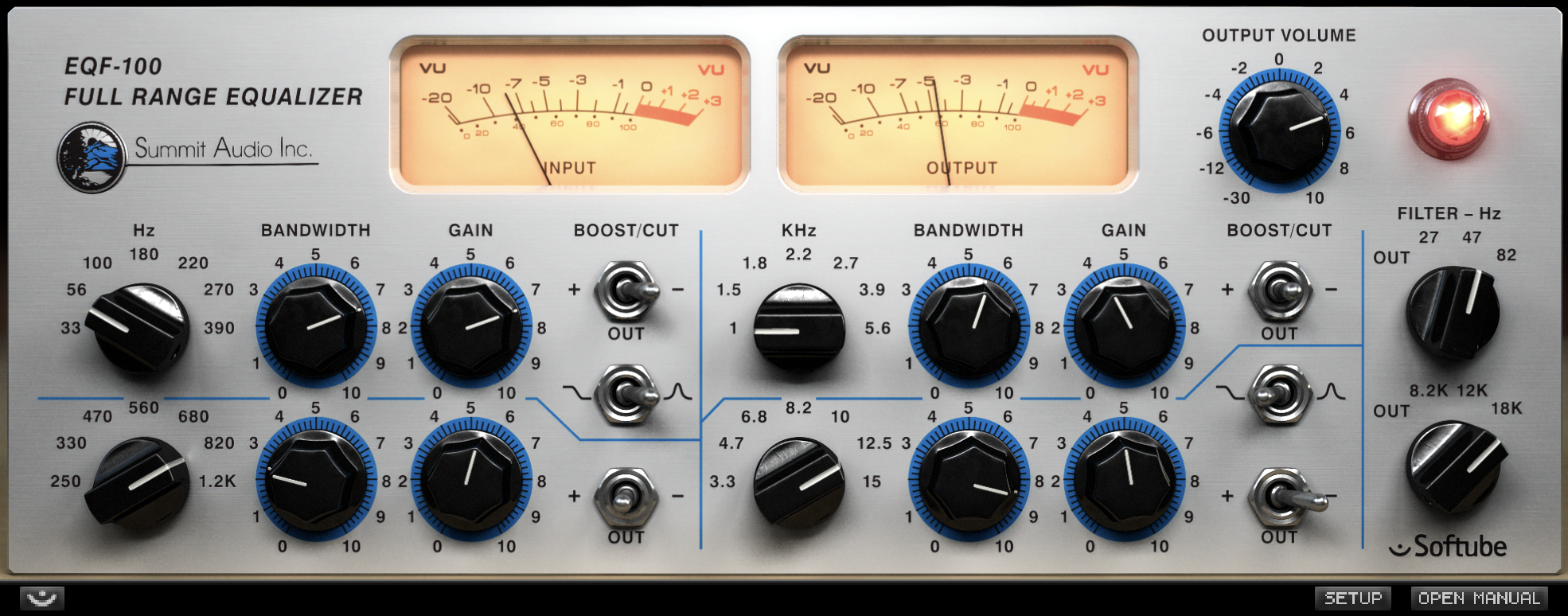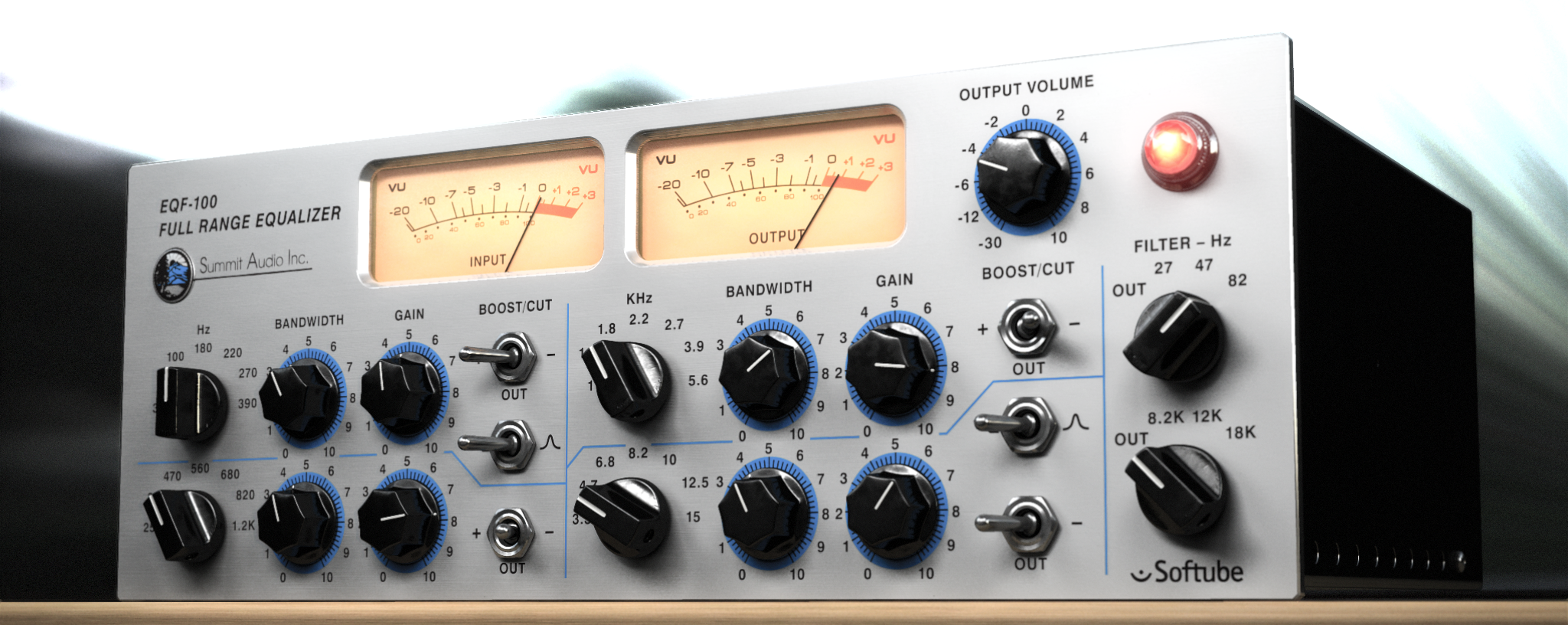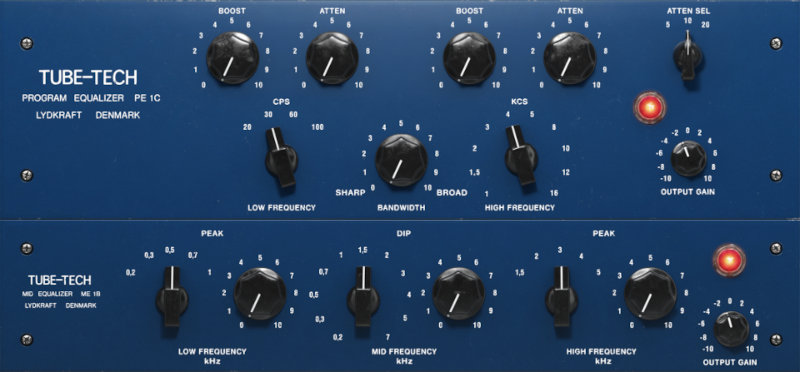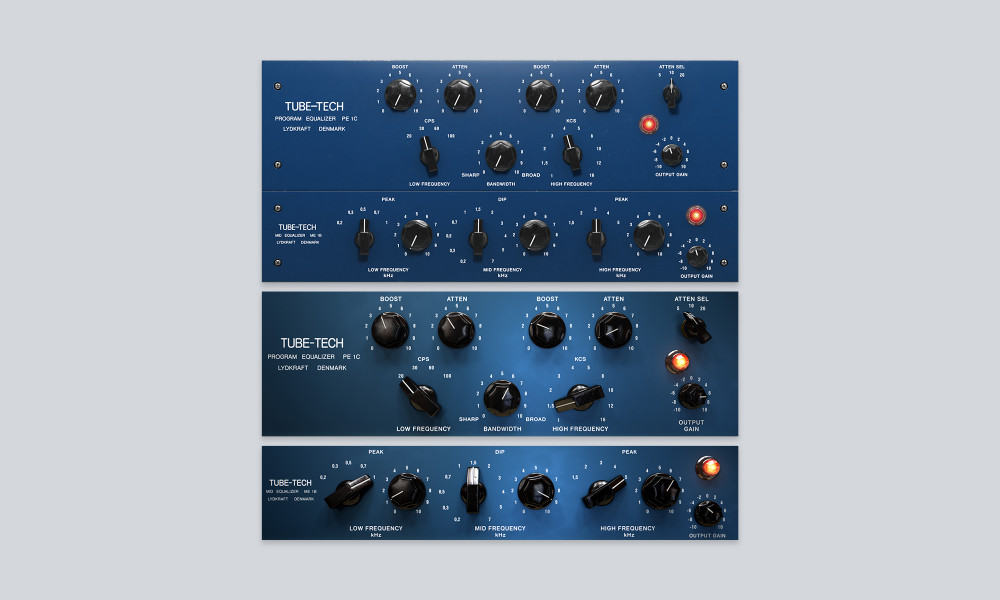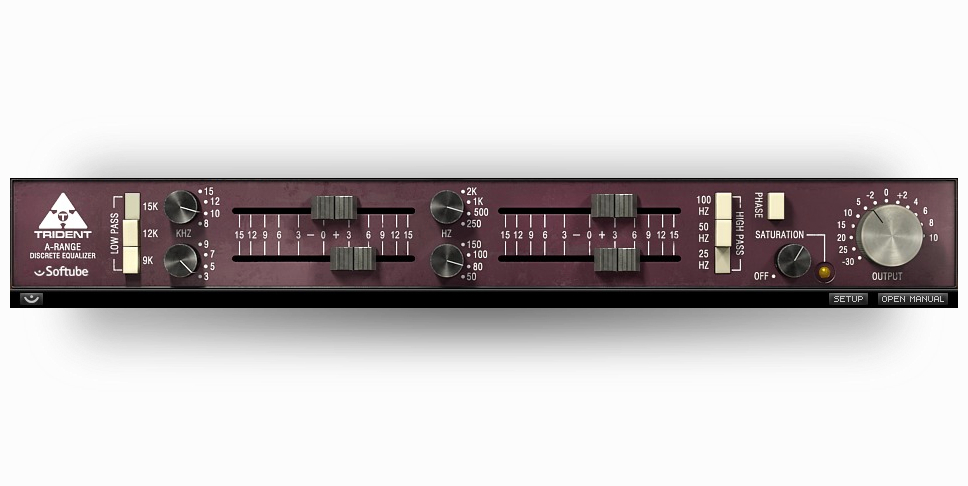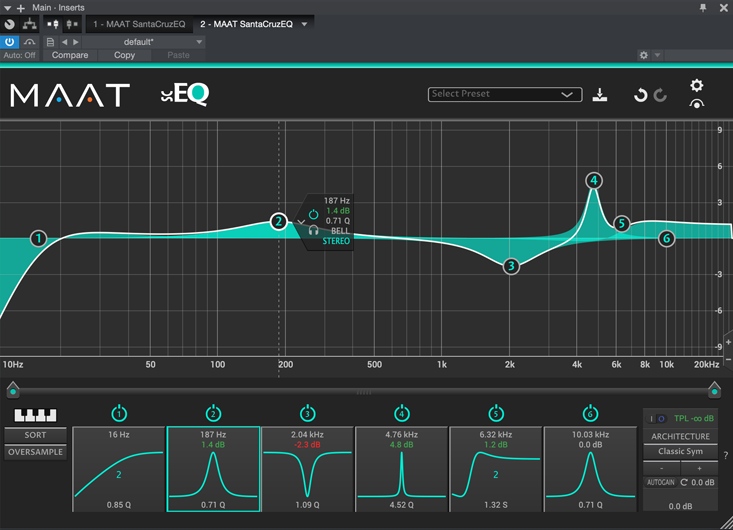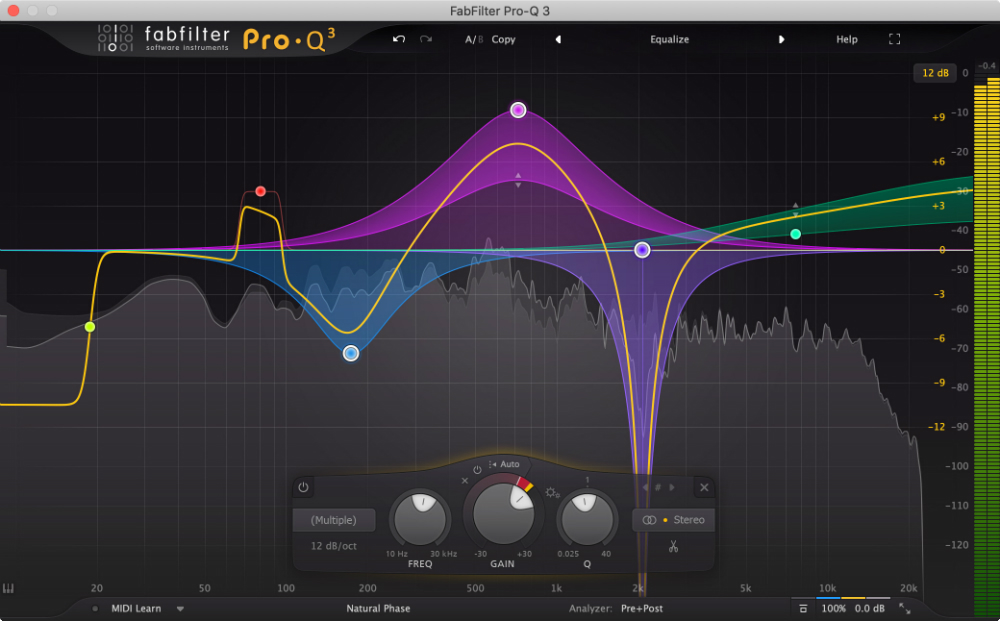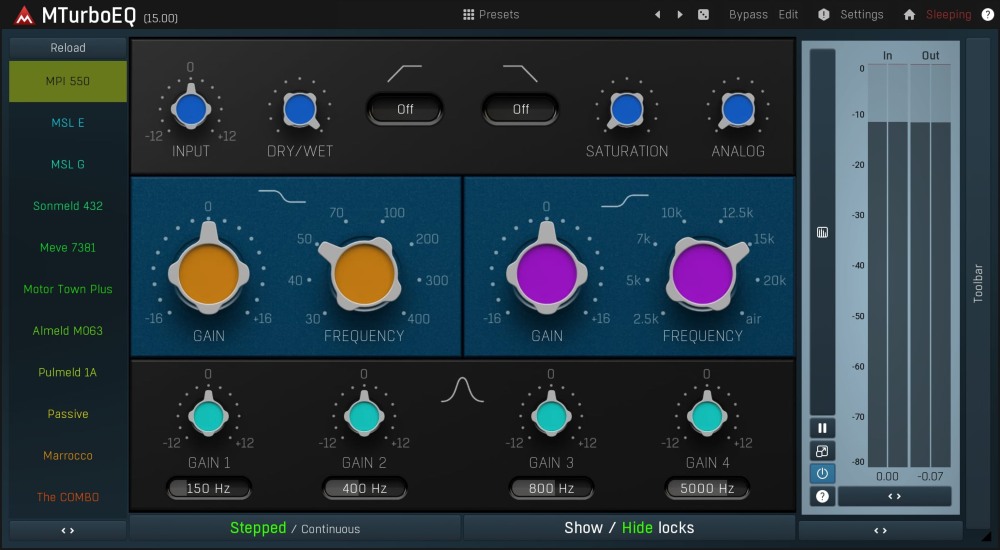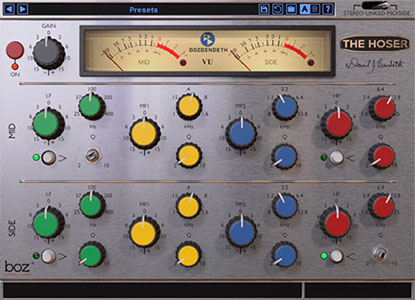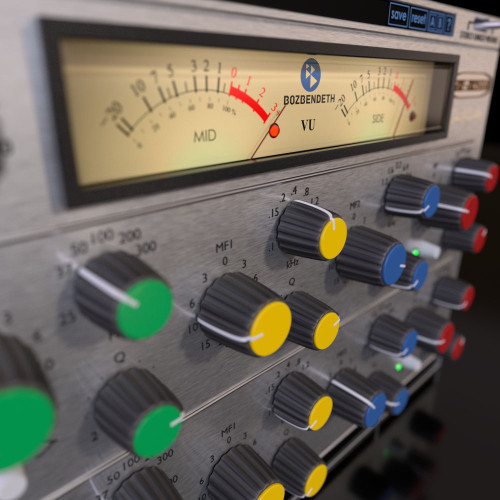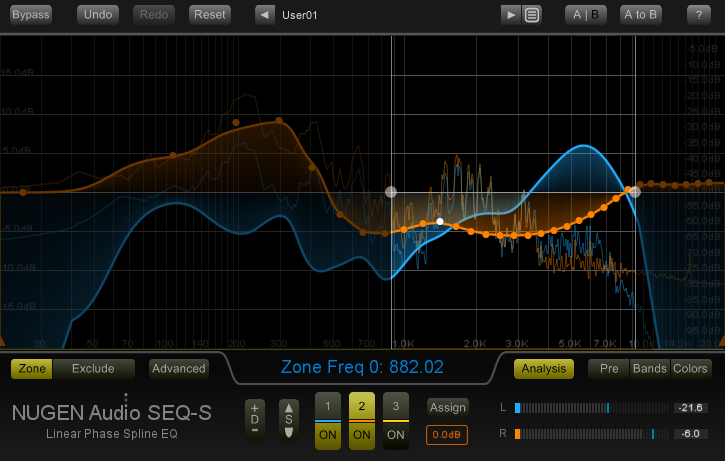Oxford Dynamic EQ HD/HDX
EQ by Sonnox
Images
Description
Have you tried to control boomy or harsh frequencies using a traditional static EQ but found you compromised the integrity of the original recording? Then found that writing automation lost you precious time and sounded unnatural? Perhaps you’ve heard that a multiband compressor is the answer but it left you scratching your head?
Then the Oxford Dynamic EQ is the tool you need, providing just the required amount of processing when you need it and takes little time to set up. 5 bands of the ultra-musical Type-3 EQ curve can be overlapped to bring unparalleled control and characteristic Sonnox transparency to your single sources, instrument groups and 2-bus alike.
The Dynamic EQ introduces unique features such as the option to engage the effect by onset (transient) detection – very useful when working with drums and percussion. Additionally, mid-side processing can be used to enhance a vocal without affecting side-channel balance or to open up a mix by focusing low-end energy in the centre.
This highly-tweakable space-carving capabilities of the Dynamic EQ will be a welcome addition to your mixing arsenal.
Video
Rating
Mac:
- macOS 10.7 or later
-
iLok USB device with latest drivers OR active internet connection required
Formats:
- AAX Native and Pro Tools HDX compatible 10.3.8, 11.3.2, 12 - Approved Pro Tools CPU, OS and hardware configuration
PC:
- Windows 7 or later
-
iLok USB device with latest drivers OR active internet connection required
Formats:
- AAX Native and HDX for Pro Tools 10.3.8, 11.3.2, 12 - Approved Pro Tools CPU, OS and hardware configuration
Important Note: This is an HD/HDX plug-in that is intended for use with the DSPs of an Avid HDX system to prevent the software from taxing your host processor. There is no difference in sound quality between the Standard and HD/HDX versions. If you do not own an Avid HDX system, all you need is the Native version.
Please Note: This product now supports iLok Cloud Authorisation. An iLok USB Dongle OR an active internet connection is required in order to activate and use this product.
Have you tried to control boomy or harsh frequencies using a traditional static EQ but found you compromised the integrity of the original recording? Then found that writing automation lost you precious time and sounded unnatural? Perhaps you’ve heard that a multiband compressor is the answer but it left you scratching your head?
Then the Oxford Dynamic EQ is the tool you need, providing just the required amount of processing when you need it and takes little time to set up. 5 bands of the ultra-musical Type-3 EQ curve can be overlapped to bring unparalleled control and characteristic Sonnox transparency to your single sources, instrument groups and 2-bus alike.
The Dynamic EQ introduces unique features such as the option to engage the effect by onset (transient) detection – very useful when working with drums and percussion. Additionally, mid-side processing can be used to enhance a vocal without affecting side-channel balance or to open up a mix by focusing low-end energy in the centre.
This highly-tweakable space-carving capabilities of the Dynamic EQ will be a welcome addition to your mixing arsenal.
Video
Rating
Mac:
- macOS 10.7 or later
- iLok USB device with latest drivers OR active internet connection required
Formats:
- AAX Native and Pro Tools HDX compatible 10.3.8, 11.3.2, 12 - Approved Pro Tools CPU, OS and hardware configuration
PC:
- Windows 7 or later
- iLok USB device with latest drivers OR active internet connection required
Formats:
- AAX Native and HDX for Pro Tools 10.3.8, 11.3.2, 12 - Approved Pro Tools CPU, OS and hardware configuration
Important Note: This is an HD/HDX plug-in that is intended for use with the DSPs of an Avid HDX system to prevent the software from taxing your host processor. There is no difference in sound quality between the Standard and HD/HDX versions. If you do not own an Avid HDX system, all you need is the Native version.
Please Note: This product now supports iLok Cloud Authorisation. An iLok USB Dongle OR an active internet connection is required in order to activate and use this product.
Oxford SuprEsser DS
EQ by Sonnox
Images
Description
The Oxford SuprEsser DS offers simple and precise control of aggressive frequencies between 1kHz & 20kHz – using the combination of 3 listen modes and a clear FFT display. Hear and see where to focus the Plug-In’s filters before dialling out a problem tone with a single control. There’s a simple mode for quick fixes with an advanced mode to hand for increased functionality and fine-tuning.
Video
Rating
Pro Tools:
- Pro Tools 10.3.8, 11.3.2, 12 - AAX Native
- Approved Pro Tools CPU, OS and hardware configuration
-
iLok USB device with latest drivers OR active internet connection required
-
iLok2 / iLok3 OR active internet connection required for AAX plug-ins
Audio Units:
- Not available
VST2:
- Not available
Compatibility:
- AAX
Supported Hosts:
Mac:
- Pro Tools 10.3.8, 11.3.2, 12 (AAX Native)
Windows:
- Pro Tools 10.3.8, 11.3.2, 12 (AAX Native)
Please Note: This product now supports iLok Cloud Authorisation. An iLok USB Dongle OR an active internet connection is required in order to activate and use this product.
The Oxford SuprEsser DS offers simple and precise control of aggressive frequencies between 1kHz & 20kHz – using the combination of 3 listen modes and a clear FFT display. Hear and see where to focus the Plug-In’s filters before dialling out a problem tone with a single control. There’s a simple mode for quick fixes with an advanced mode to hand for increased functionality and fine-tuning.
Video
Rating
Pro Tools:
- Pro Tools 10.3.8, 11.3.2, 12 - AAX Native
- Approved Pro Tools CPU, OS and hardware configuration
- iLok USB device with latest drivers OR active internet connection required
- iLok2 / iLok3 OR active internet connection required for AAX plug-ins
Audio Units:
- Not available
VST2:
- Not available
Compatibility:
- AAX
Supported Hosts:
Mac:
- Pro Tools 10.3.8, 11.3.2, 12 (AAX Native)
Windows:
- Pro Tools 10.3.8, 11.3.2, 12 (AAX Native)
Please Note: This product now supports iLok Cloud Authorisation. An iLok USB Dongle OR an active internet connection is required in order to activate and use this product.
Weiss EQ1
EQ by Softube
Images
Description
Note: The following upgrade is also available:
A 1:1 Code Port of the Weiss EQ with No Equal
Overview
- A line-by-line code port boasting 1:1 accuracy of the pioneering original hardware, known as the standard of digital mastering EQs.
- Increased functionality of the original algorithms, plus 32-bit / 192 kHz operation and updated ergonomics.
- Easy manual recall of Presets that sound and behave exactly like they do in the hardware.
There’s a reason Weiss Engineering’s EQ1 has been at the top of the heap since its release in 1996. The EQ1’s dazzling sonic qualities combined with its flexibility as either a Minimum Phase EQ, a Linear Phase EQ, or a Dynamic EQ have made it the must-have digital mastering equalizer. The Weiss EQ1 plug-in crystallizes that legacy—in software form.
Weiss Engineering’s go-to hardware and Softube’s workflow and ergonomic advancements combine here to stunning effect. A one-for-one, line-by-line code port of the original, the EQ1 plug-in is the latest and greatest addition to Softube’s successful partnership with Weiss Engineering. EQ1 joins DS1-MK3, MM-1, and more out-of-this-world Weiss + Softube products to prove that Swiss and Swedish engineering make a stellar pair.
Doppelgänger
The EQ1 plug-in is a true line-by-line port of the original SHARC assembler code. It’s an accurate replica that functions just like the original, but with added features that take it higher.
Colossal Heights
The Weiss EQ1 is the mammoth of equalizers, but Softube felt compelled to go further. Softube and Weiss gave the EQ1 plug-in a higher sample rate, improved ergonomics, and increased functionality.
Picture Perfect
The EQ1 plug-in lets you easily recall Presets (or Snapshots in the hardware counterpart) manually and they'll sound and behave precisely as they do in the hardware.
The Original and Still the Best
The original Weiss EQ1 is the stick by which all digital mastering EQs are measured. EQ1 boasts seven identical parametric bands that cover the entire audio frequency range and have an incredible Q-parameter range of 0.2 to 650. Each EQ band has Boost/Cut, Frequency, and Q/Slope knobs and operate in any of the following modes: High-shelving, Low-shelving, Peaking, High-cut, Low-cut, and Bypass. High auditory quality and functional design made the EQ1 a bestseller in 1996 and solidified its status as the top digital mastering EQ in the field going forward.
![]()
A Software Scion
An astonishingly accurate model of the hardware, the Softube + Weiss EQ1 plug-in covers all configurations and functions internally just as the original unit does. The saved Presets (or Snapshots, as they are referred to in the hardware) can easily be manually recalled to the plug-in and will sound and behave identically. The EQ1 plug-in is no pretender; it’s the real deal with extra features that make it an invaluable asset.
![]()
Raising the Bar
With every new iteration of EQ1, the standard has been set higher. The EQ1 plug-in is not an exception to this rule. Not only can you set the Threshold, but now you can also set Attack, Release, and Ratio in Advanced Dynamic Mode. The hardware allows four bands to function as dynamic bands, while the EQ1 software version kicks it into high gear and lets you activate all seven bands in Dynamic Mode. The additional components of the Weiss EQ1 plug-in have it racing ahead.
![]()
Flat-out Fantastic
When porting the code from the original hardware, Softube strove to be exacting, as always. But, true to form, they didn’t stop at perfection. Softube added innovative features that make the workflow speedier. The Weiss EQ1 plug-in user interface is a replica of the hardware, but now it adapts depending on the setting of the four distinct user interface configurations. The knob layout changes according to which modes of the unit are activated. In this way, the parameters are available at all times—independent of what mode is chosen—making access to them simpler and faster than ever before.
![]()
Softube & Weiss: Meeting of the Minds
Weiss has been a pioneer in digital audio equipment design since 1979. That’s when Weiss founder, Daniel Weiss, joined Willi Studer AG in Switzerland as an engineer. In 1985, Weiss struck out on his own and founded Weiss Engineering with a focus on pioneering digital audio equipment for Mastering Studios. The result of that endeavour is now legend.
Softube’s relationship with Weiss started in 2008 when they were first introduced to Daniel Weiss. Despite having so many guiding principles in common, it wasn’t until 2015 that Softube got serious about working together. Three years—and some blood, sweat, and tears—later, the Softube + Weiss DS1-MK3 plug-in was unveiled to great fanfare. And the tradition continues.
![]()
Video
Rating
- Mac OS X 10.13 or newer (older OS versions will not work) (64-bit only).
- Windows 10 64-bit (older Windows versions may work but are not tested) (64-bit only).
- Mac: Intel Core i3 / i5 / i7 / Xeon - M1 support pending.
- Windows: Intel Core i3 / i5 / i7 / Xeon / AMD Quad-Core or newer.
- Screen resolution 1280x800 or larger.
- Supported sample rates: 44.1, 48, 88.2, 96, 176.4 and 192 kHz, in both mono and stereo.
- 8 GB RAM or more is recommended, as well as at least 8 GB hard disk space for installation (individual plug-ins take less space, while sample libraries may require additional disk space).
- A Softube account is required to register and install the software.
- An iLok account is required for authorisation of the software.
- Internet access for downloading installer and managing licenses.
- iLok generation 2 and up, if you intend to use a physical iLok dongle for authorizing your plug-ins (note that an iLok dongle is not a requirement).
- In theory, any 64-bit VST, VST3, AU, or AAX (11.0.2 or higher) compatible host application should work.
- The most recent maintenance release of the DAW application is recommended.
However, due to plug-in host differences between DAWs - and Softube's own rigorous testing standards - Softube only officially test their plug-ins and instruments in the most recent versions of Pro Tools, Logic Pro, Cubase, Live, Studio One, Digital Performer, Reaper and Sonar. Softube plugins are not tested in the non-listed systems, but they most likely work as long as the system requirements are met.
Important note: make sure that you always use the latest iLok License Manager. It is not included in the Softube installer but can be downloaded from www.ilok.com
Note: The following upgrade is also available:
A 1:1 Code Port of the Weiss EQ with No Equal
Overview
- A line-by-line code port boasting 1:1 accuracy of the pioneering original hardware, known as the standard of digital mastering EQs.
- Increased functionality of the original algorithms, plus 32-bit / 192 kHz operation and updated ergonomics.
- Easy manual recall of Presets that sound and behave exactly like they do in the hardware.
There’s a reason Weiss Engineering’s EQ1 has been at the top of the heap since its release in 1996. The EQ1’s dazzling sonic qualities combined with its flexibility as either a Minimum Phase EQ, a Linear Phase EQ, or a Dynamic EQ have made it the must-have digital mastering equalizer. The Weiss EQ1 plug-in crystallizes that legacy—in software form.
Weiss Engineering’s go-to hardware and Softube’s workflow and ergonomic advancements combine here to stunning effect. A one-for-one, line-by-line code port of the original, the EQ1 plug-in is the latest and greatest addition to Softube’s successful partnership with Weiss Engineering. EQ1 joins DS1-MK3, MM-1, and more out-of-this-world Weiss + Softube products to prove that Swiss and Swedish engineering make a stellar pair.
Doppelgänger
The EQ1 plug-in is a true line-by-line port of the original SHARC assembler code. It’s an accurate replica that functions just like the original, but with added features that take it higher.
Colossal Heights
The Weiss EQ1 is the mammoth of equalizers, but Softube felt compelled to go further. Softube and Weiss gave the EQ1 plug-in a higher sample rate, improved ergonomics, and increased functionality.
Picture Perfect
The EQ1 plug-in lets you easily recall Presets (or Snapshots in the hardware counterpart) manually and they'll sound and behave precisely as they do in the hardware.
The Original and Still the Best
The original Weiss EQ1 is the stick by which all digital mastering EQs are measured. EQ1 boasts seven identical parametric bands that cover the entire audio frequency range and have an incredible Q-parameter range of 0.2 to 650. Each EQ band has Boost/Cut, Frequency, and Q/Slope knobs and operate in any of the following modes: High-shelving, Low-shelving, Peaking, High-cut, Low-cut, and Bypass. High auditory quality and functional design made the EQ1 a bestseller in 1996 and solidified its status as the top digital mastering EQ in the field going forward.
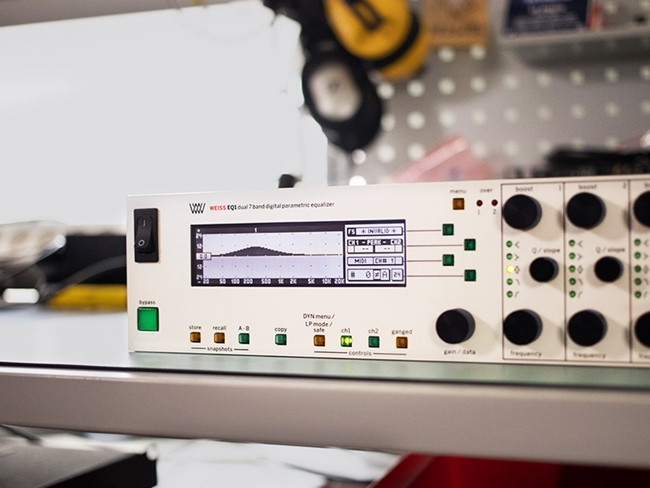
A Software Scion
An astonishingly accurate model of the hardware, the Softube + Weiss EQ1 plug-in covers all configurations and functions internally just as the original unit does. The saved Presets (or Snapshots, as they are referred to in the hardware) can easily be manually recalled to the plug-in and will sound and behave identically. The EQ1 plug-in is no pretender; it’s the real deal with extra features that make it an invaluable asset.
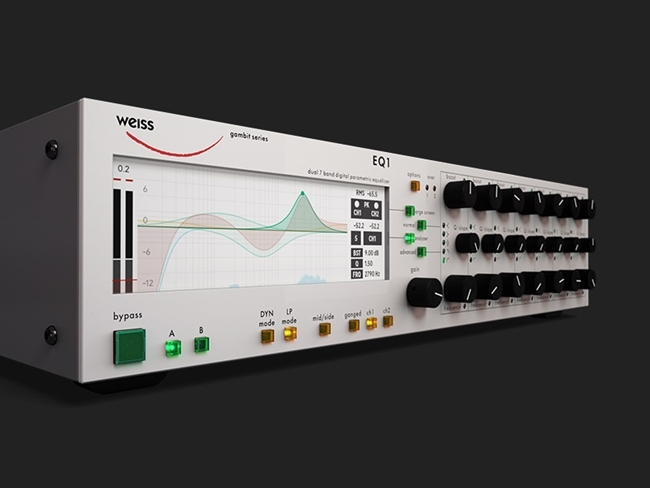
Raising the Bar
With every new iteration of EQ1, the standard has been set higher. The EQ1 plug-in is not an exception to this rule. Not only can you set the Threshold, but now you can also set Attack, Release, and Ratio in Advanced Dynamic Mode. The hardware allows four bands to function as dynamic bands, while the EQ1 software version kicks it into high gear and lets you activate all seven bands in Dynamic Mode. The additional components of the Weiss EQ1 plug-in have it racing ahead.
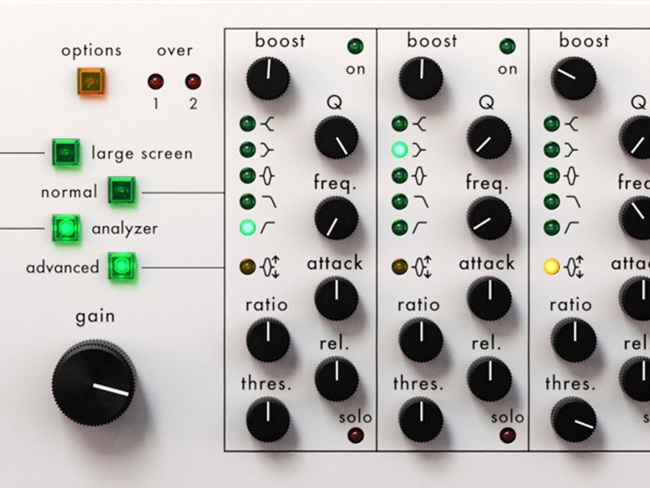
Flat-out Fantastic
When porting the code from the original hardware, Softube strove to be exacting, as always. But, true to form, they didn’t stop at perfection. Softube added innovative features that make the workflow speedier. The Weiss EQ1 plug-in user interface is a replica of the hardware, but now it adapts depending on the setting of the four distinct user interface configurations. The knob layout changes according to which modes of the unit are activated. In this way, the parameters are available at all times—independent of what mode is chosen—making access to them simpler and faster than ever before.
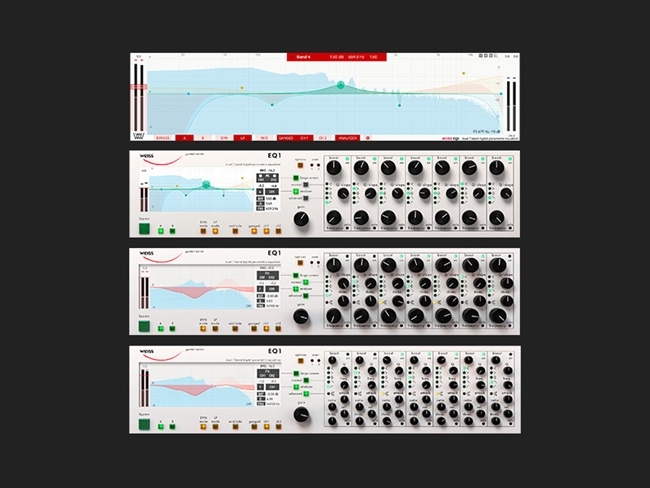
Softube & Weiss: Meeting of the Minds
Weiss has been a pioneer in digital audio equipment design since 1979. That’s when Weiss founder, Daniel Weiss, joined Willi Studer AG in Switzerland as an engineer. In 1985, Weiss struck out on his own and founded Weiss Engineering with a focus on pioneering digital audio equipment for Mastering Studios. The result of that endeavour is now legend.
Softube’s relationship with Weiss started in 2008 when they were first introduced to Daniel Weiss. Despite having so many guiding principles in common, it wasn’t until 2015 that Softube got serious about working together. Three years—and some blood, sweat, and tears—later, the Softube + Weiss DS1-MK3 plug-in was unveiled to great fanfare. And the tradition continues.
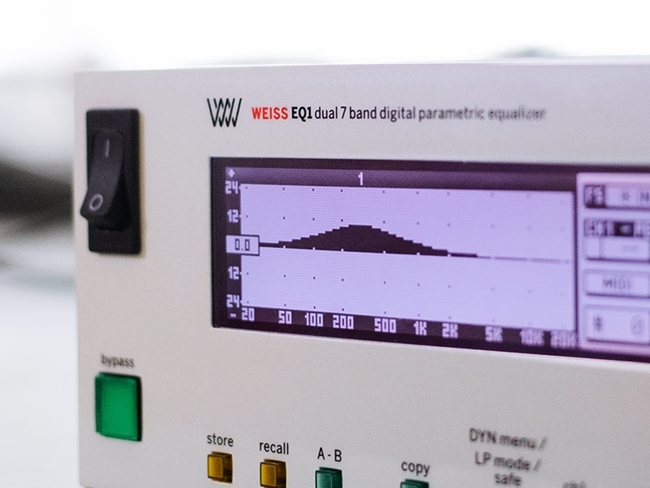
Video
Rating
- Mac OS X 10.13 or newer (older OS versions will not work) (64-bit only).
- Windows 10 64-bit (older Windows versions may work but are not tested) (64-bit only).
- Mac: Intel Core i3 / i5 / i7 / Xeon - M1 support pending.
- Windows: Intel Core i3 / i5 / i7 / Xeon / AMD Quad-Core or newer.
- Screen resolution 1280x800 or larger.
- Supported sample rates: 44.1, 48, 88.2, 96, 176.4 and 192 kHz, in both mono and stereo.
- 8 GB RAM or more is recommended, as well as at least 8 GB hard disk space for installation (individual plug-ins take less space, while sample libraries may require additional disk space).
- A Softube account is required to register and install the software.
- An iLok account is required for authorisation of the software.
- Internet access for downloading installer and managing licenses.
- iLok generation 2 and up, if you intend to use a physical iLok dongle for authorizing your plug-ins (note that an iLok dongle is not a requirement).
- In theory, any 64-bit VST, VST3, AU, or AAX (11.0.2 or higher) compatible host application should work.
- The most recent maintenance release of the DAW application is recommended.
However, due to plug-in host differences between DAWs - and Softube's own rigorous testing standards - Softube only officially test their plug-ins and instruments in the most recent versions of Pro Tools, Logic Pro, Cubase, Live, Studio One, Digital Performer, Reaper and Sonar. Softube plugins are not tested in the non-listed systems, but they most likely work as long as the system requirements are met.
Important note: make sure that you always use the latest iLok License Manager. It is not included in the Softube installer but can be downloaded from www.ilok.com
SSL Native X-EQ 2
EQ by Solid State Logic
Images
Description
![]()
The Ultimate SSL EQ for your DAW
X-EQ 2 is the ultimate SSL EQ toolkit for audio professionals. Built upon SSL’s proprietary anti-cramping algorithms, X-EQ 2 simply sounds stunning. With 17 different classic and modern EQ type/curve options, X-EQ 2 is a formidable and powerful contender to be your new ‘go-to’ EQ plug-in.
X-EQ 2 is a highly configurable 24-band EQ plug-in, featuring unique anti-cramping algorithms for an unparalleled open and transparent sound. It’s the ultimate EQ toolkit, with 17 different EQ types and filter shapes. Each band is switchable between bell, shelf, low pass or high pass filter types, with both classic and customisable shapes available for each band. It features brand new spatial processing options, band soloing, and the classic X-EQ 'Parallel' mode for recreating the characteristic sound of old parallel passive EQ circuits.
Video
Rating
Mac
- macOS Sierra (10.12) or higher (64-bit only)
- Intel Dual Core Mac running at 2.4GHz or higher
- 4GB of RAM minimum, 8GB preferable
- AU, VST2, VST3, AAX Native
Windows
- Windows 7, 8, 8.1, and Windows 10 (64-bit only)
- Intel Core 2 (or comparable) CPU running at 2.4GHz or higher
- 4GB of RAM minimum, 8GB preferable
- VST 2, VST3, AAX Native#
Please note: A FREE iLok Account is required for authorisation of this software.
The Ultimate SSL EQ for your DAW
X-EQ 2 is the ultimate SSL EQ toolkit for audio professionals. Built upon SSL’s proprietary anti-cramping algorithms, X-EQ 2 simply sounds stunning. With 17 different classic and modern EQ type/curve options, X-EQ 2 is a formidable and powerful contender to be your new ‘go-to’ EQ plug-in.
X-EQ 2 is a highly configurable 24-band EQ plug-in, featuring unique anti-cramping algorithms for an unparalleled open and transparent sound. It’s the ultimate EQ toolkit, with 17 different EQ types and filter shapes. Each band is switchable between bell, shelf, low pass or high pass filter types, with both classic and customisable shapes available for each band. It features brand new spatial processing options, band soloing, and the classic X-EQ 'Parallel' mode for recreating the characteristic sound of old parallel passive EQ circuits.
Video
Rating
Mac
- macOS Sierra (10.12) or higher (64-bit only)
- Intel Dual Core Mac running at 2.4GHz or higher
- 4GB of RAM minimum, 8GB preferable
- AU, VST2, VST3, AAX Native
Windows
- Windows 7, 8, 8.1, and Windows 10 (64-bit only)
- Intel Core 2 (or comparable) CPU running at 2.4GHz or higher
- 4GB of RAM minimum, 8GB preferable
- VST 2, VST3, AAX Native#
Please note: A FREE iLok Account is required for authorisation of this software.
Chandler Limited® Curve Bender Mastering EQ
EQ by Softube
Images
Description
Sovereign of Analog Mastering Equalizers
If there was a hierarchy of analog studio gear (and let’s face it, there kind of is) it’d be hard to dispute the Chandler Limited® Curve Bender’s claim to the throne. Among analog mastering grade equalizers, this one’s about as blue-blooded as they come.
With tremendous pedigree, huge yet controlled power, and most importantly, exceptional sound quality, thanks to component-level modelling of the original germanium and inductor circuits, the Curve Bender, now available for the first time in native format, reigns supreme over the domain of tone-shaping in analog mastering.
![]()
Legendary Circuits
The sound of this unit comes from equalizer circuits which can trace their lineage back to one of the most legendary high-end British consoles of all time, the EMI TG12345.
Subtle, yet powerful
With its gentle, carefully designed curves, silky top-end, and tight lows, it’s impossible not to improve your sound. Just set and forget.
Modern Royalty
In software form, the majestic sound quality of the Curve Bender is only built upon and expanded by the addition of Mid/Side processing.
Impeccable Lineage
The Chandler Limited® Curve Bender is based on desk circuits from the world-famous Abbey Road Studios in London, used to create albums of genuinely legendary status, such as Dark Side Of The Moon by Pink Floyd, and Abbey Road by The Beatles. And as with any truly supreme successor to a noble line, it builds on the greatness of its ancestors.
The Curve Bender has more bands (four, compared to the original console’s two), more fixed filter points (a huge fifty-one, up from just nine, chosen and designed in the image of the original circuits by Chandler Limited® founder, Wade Goeke), more Q and gain options, and added low and high pass filters, making the unit a mastering powerhouse without sacrificing the exquisite analog sound-flavor which made it a leader.
![]()
Modern Power
In software form, the Curve Bender plug-in not only allows you the luxury of using this ultra-special crown-jewel mastering EQ in multiple places in the same mix (across instrument groups AND the master bus, for example), but also adds functionality to the original hardware, with Mid/Side processing and channel linking. From left to right, mid to side, everything the light touches is yours.
A mastering grade processor, the Curve Bender is perfect for gently sculpting the entire mix, with never a hint of harshness despite its endless power.
![]()
Professional presets
To help you get the best out of the Curve Bender, we've asked some top professional mixing and mastering engineers to create presets. Quickly and easily dial in a sound you like by referencing Joe Chicarelli, Tony Maserati, Howard Willing, Kevin Kadish, and Maor Appelbaum.
![]()
Mastering, in particular, is all about subtlety, so you'll want to tweak to taste, but these professional presets will give you great ideas, and get you in the ballpark of a stellar sound in seconds.
A Crowning Glory
Not all equalizers are created equal. The crisp, powerful, performance of the Chandler Limited® Curve Bender will open up the soundscape of any song, and take it to glorious new levels. Whether on the master bus, the drum group, or a lead vocal track, this kind of quality rules your sound without being brash or crude. It’s refined, natural, regal, and it will elevate your mixes whether you’re a club DJ, an urban poet beatmaker, a rock & roll rebel, or a pop princess. All people are the Curve Bender’s people.
![]()
In Short
- Mastering grade analog equalizer.
- Silky top-end and tight lows.
- Based on legendary British console EQ circuits used on innumerable classic records.
- Professional engineer presets from Joe Chicarelli, Tony Maserati, Howard Willing, Kevin Kadish, and Maor Appelbaum.
- Improved with more bands, more filter-points, greater gain and Q flexibility, and additional low and high pass filters.
- Added Mid/Side processing and channel linking in the plug-in.
- Subtle yet authoritative; carefully considered curves and exceptional quality mean you can boost with confidence.
- Set it and forget it – it always sounds good.
- Use on master bus, instrument groups, or even individual tracks – it’s great on vocals.
- A real crown jewel in your collection.
Video
Rating
- Mac OS X 10.13 or newer (older OS versions will not work) (64-bit only).
- Windows 10 64-bit (older Windows versions may work but are not tested) (64-bit only).
- Mac: Intel Core i3 / i5 / i7 / Xeon - M1 support pending.
- Windows: Intel Core i3 / i5 / i7 / Xeon / AMD Quad-Core or newer.
- Screen resolution 1280x800 or larger.
- Supported sample rates: 44.1, 48, 88.2, 96, 176.4 and 192 kHz, in both mono and stereo.
- 8 GB RAM or more is recommended, as well as at least 8 GB hard disk space for installation (individual plug-ins take less space, while sample libraries may require additional disk space).
- A Softube account is required to register and install the software.
- An iLok account is required for authorisation of the software.
- Internet access for downloading installer and managing licenses.
- iLok generation 2 and up, if you intend to use a physical iLok dongle for authorizing your plug-ins (note that an iLok dongle is not a requirement).
- In theory, any 64-bit VST, VST3, AU, or AAX (11.0.2 or higher) compatible host application should work.
- The most recent maintenance release of the DAW application is recommended.
However, due to plug-in host differences between DAWs - and Softube's own rigorous testing standards - Softube only officially test their plug-ins and instruments in the most recent versions of Pro Tools, Logic Pro, Cubase, Live, Studio One, Digital Performer, Reaper and Sonar. Softube plugins are not tested in the non-listed systems, but they most likely work as long as the system requirements are met.
Important note: make sure that you always use the latest iLok License Manager. It is not included in the Softube installer but can be downloaded from www.ilok.com
Sovereign of Analog Mastering Equalizers
If there was a hierarchy of analog studio gear (and let’s face it, there kind of is) it’d be hard to dispute the Chandler Limited® Curve Bender’s claim to the throne. Among analog mastering grade equalizers, this one’s about as blue-blooded as they come.
With tremendous pedigree, huge yet controlled power, and most importantly, exceptional sound quality, thanks to component-level modelling of the original germanium and inductor circuits, the Curve Bender, now available for the first time in native format, reigns supreme over the domain of tone-shaping in analog mastering.

Legendary Circuits
The sound of this unit comes from equalizer circuits which can trace their lineage back to one of the most legendary high-end British consoles of all time, the EMI TG12345.
Subtle, yet powerful
With its gentle, carefully designed curves, silky top-end, and tight lows, it’s impossible not to improve your sound. Just set and forget.
Modern Royalty
In software form, the majestic sound quality of the Curve Bender is only built upon and expanded by the addition of Mid/Side processing.
Impeccable Lineage
The Chandler Limited® Curve Bender is based on desk circuits from the world-famous Abbey Road Studios in London, used to create albums of genuinely legendary status, such as Dark Side Of The Moon by Pink Floyd, and Abbey Road by The Beatles. And as with any truly supreme successor to a noble line, it builds on the greatness of its ancestors.
The Curve Bender has more bands (four, compared to the original console’s two), more fixed filter points (a huge fifty-one, up from just nine, chosen and designed in the image of the original circuits by Chandler Limited® founder, Wade Goeke), more Q and gain options, and added low and high pass filters, making the unit a mastering powerhouse without sacrificing the exquisite analog sound-flavor which made it a leader.
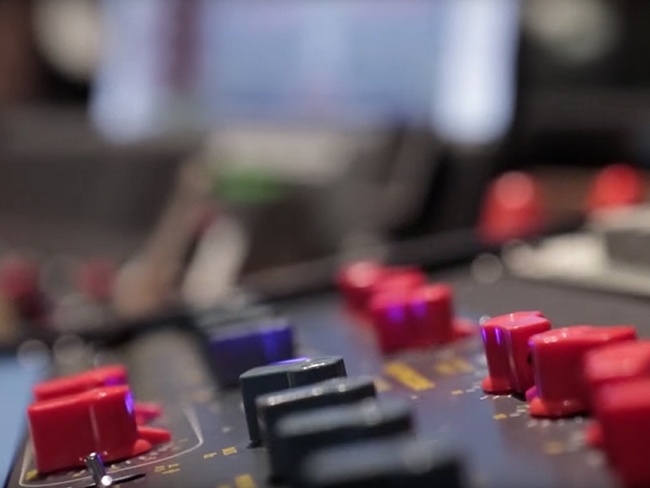
Modern Power
In software form, the Curve Bender plug-in not only allows you the luxury of using this ultra-special crown-jewel mastering EQ in multiple places in the same mix (across instrument groups AND the master bus, for example), but also adds functionality to the original hardware, with Mid/Side processing and channel linking. From left to right, mid to side, everything the light touches is yours.
A mastering grade processor, the Curve Bender is perfect for gently sculpting the entire mix, with never a hint of harshness despite its endless power.
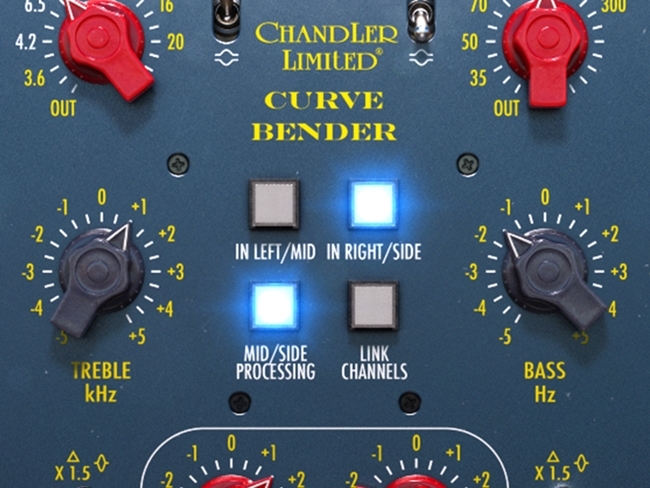
Professional presets
To help you get the best out of the Curve Bender, we've asked some top professional mixing and mastering engineers to create presets. Quickly and easily dial in a sound you like by referencing Joe Chicarelli, Tony Maserati, Howard Willing, Kevin Kadish, and Maor Appelbaum.
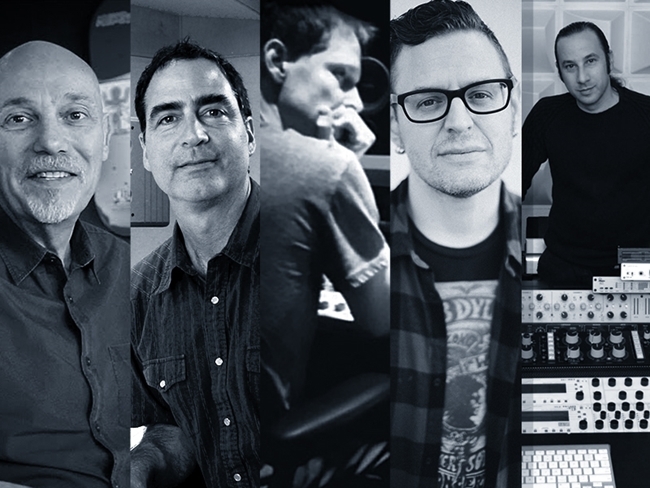
Mastering, in particular, is all about subtlety, so you'll want to tweak to taste, but these professional presets will give you great ideas, and get you in the ballpark of a stellar sound in seconds.
A Crowning Glory
Not all equalizers are created equal. The crisp, powerful, performance of the Chandler Limited® Curve Bender will open up the soundscape of any song, and take it to glorious new levels. Whether on the master bus, the drum group, or a lead vocal track, this kind of quality rules your sound without being brash or crude. It’s refined, natural, regal, and it will elevate your mixes whether you’re a club DJ, an urban poet beatmaker, a rock & roll rebel, or a pop princess. All people are the Curve Bender’s people.
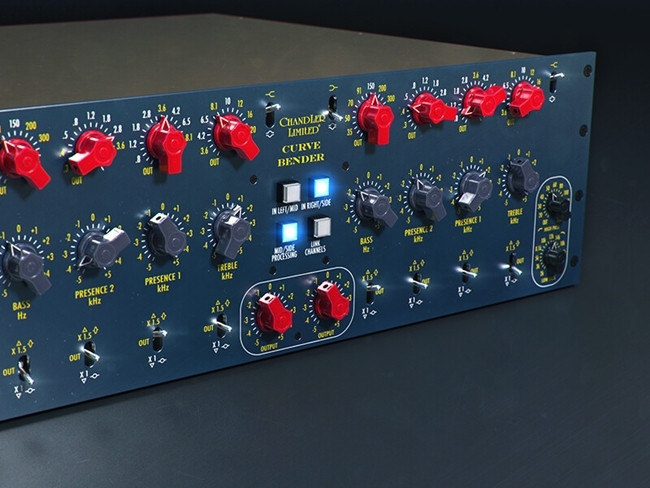
In Short
- Mastering grade analog equalizer.
- Silky top-end and tight lows.
- Based on legendary British console EQ circuits used on innumerable classic records.
- Professional engineer presets from Joe Chicarelli, Tony Maserati, Howard Willing, Kevin Kadish, and Maor Appelbaum.
- Improved with more bands, more filter-points, greater gain and Q flexibility, and additional low and high pass filters.
- Added Mid/Side processing and channel linking in the plug-in.
- Subtle yet authoritative; carefully considered curves and exceptional quality mean you can boost with confidence.
- Set it and forget it – it always sounds good.
- Use on master bus, instrument groups, or even individual tracks – it’s great on vocals.
- A real crown jewel in your collection.
Video
Rating
- Mac OS X 10.13 or newer (older OS versions will not work) (64-bit only).
- Windows 10 64-bit (older Windows versions may work but are not tested) (64-bit only).
- Mac: Intel Core i3 / i5 / i7 / Xeon - M1 support pending.
- Windows: Intel Core i3 / i5 / i7 / Xeon / AMD Quad-Core or newer.
- Screen resolution 1280x800 or larger.
- Supported sample rates: 44.1, 48, 88.2, 96, 176.4 and 192 kHz, in both mono and stereo.
- 8 GB RAM or more is recommended, as well as at least 8 GB hard disk space for installation (individual plug-ins take less space, while sample libraries may require additional disk space).
- A Softube account is required to register and install the software.
- An iLok account is required for authorisation of the software.
- Internet access for downloading installer and managing licenses.
- iLok generation 2 and up, if you intend to use a physical iLok dongle for authorizing your plug-ins (note that an iLok dongle is not a requirement).
- In theory, any 64-bit VST, VST3, AU, or AAX (11.0.2 or higher) compatible host application should work.
- The most recent maintenance release of the DAW application is recommended.
However, due to plug-in host differences between DAWs - and Softube's own rigorous testing standards - Softube only officially test their plug-ins and instruments in the most recent versions of Pro Tools, Logic Pro, Cubase, Live, Studio One, Digital Performer, Reaper and Sonar. Softube plugins are not tested in the non-listed systems, but they most likely work as long as the system requirements are met.
Important note: make sure that you always use the latest iLok License Manager. It is not included in the Softube installer but can be downloaded from www.ilok.com
Oxford EQ V3
EQ by Sonnox
Images
Description
A great sounding EQ is essential to any mix. Which EQ to use can vary depending on artistic requirement, but quality and flexibility are both critical at all times. What if there was one Plug-In with four distinct EQ types – from surgical to musical – with a track record of being used to mix the biggest hits, films, and live shows?
Enter our flagship Oxford EQ, a Plug-In that traces its heritage to the original EQ section on the acclaimed Sony OXF-R3 digital console. Hallmark sonic transparency meets a simple and interactive interface – resulting in quick, confident and great sounding mix decisions.
Video
Rating
Pro Tools
- Pro Tools 10.3.8, 11.3.2, 12 (AAX Native)
- Pro Tools 7, 8, 9, 10 (RTAS)
- Approved Pro Tools CPU, OS and hardware configuration: www.avid.com
- Legacy support for OS X 10.4.11 – 10.6.8 & Windows XP: RTAS
-
iLok USB device with latest drivers OR active internet connection required
-
iLok2 / iLok3 OR active internet connection required for AAX plug-ins
Audio Units
- Audio Units-compatible application (Logic, Digital Performer etc)
- Mac OS X 10.7 – 10.11
- (El Capitan supported where confirmed by host DAW manufacturer)
- Legacy 32-bit support for OS X 10.4.11 – 10.6.8
-
iLok USB device with latest drivers OR active internet connection required
-
iLok2 / iLok3 OR active internet connection required for 64-bit plug-ins
VST2
- VST2-compatible application (Cubase, Nuendo, Sequoia etc)
- Mac OS X 10.7 – 10.11
- (El Capitan supported where confirmed by host DAW manufacturer)
- Windows 7 or later
- Legacy 32-bit support for OS X 10.4.11 – 10.6.8 & Windows XP
-
iLok USB device with latest drivers OR active internet connection required
-
iLok2 / iLok3 OR active internet connection required for 64-bit plug-ins
Supported Hosts
Mac:
- Pro Tools 10.3.8 – 12 (AAX Native)
- Pro Tools 7 – 10 (RTAS)
- Logic Pro X 10.2
- Logic 8 & 9
- Digital Performer
- Nuendo
- Cubase
- Ableton
- Studio 1
Windows:
- Pro Tools 10.3.8 – 12 (AAX Native)
- Pro Tools 7 – 10 (RTAS)
- Nuendo
- Cubase
- Ableton
- Samplitude
- Sequoia
- Pyramix
- Studio 1
Please Note: This product now supports iLok Cloud Authorisation. An iLok USB Dongle OR an active internet connection is required in order to activate and use this product.
A great sounding EQ is essential to any mix. Which EQ to use can vary depending on artistic requirement, but quality and flexibility are both critical at all times. What if there was one Plug-In with four distinct EQ types – from surgical to musical – with a track record of being used to mix the biggest hits, films, and live shows?
Enter our flagship Oxford EQ, a Plug-In that traces its heritage to the original EQ section on the acclaimed Sony OXF-R3 digital console. Hallmark sonic transparency meets a simple and interactive interface – resulting in quick, confident and great sounding mix decisions.
Video
Rating
Pro Tools
- Pro Tools 10.3.8, 11.3.2, 12 (AAX Native)
- Pro Tools 7, 8, 9, 10 (RTAS)
- Approved Pro Tools CPU, OS and hardware configuration: www.avid.com
- Legacy support for OS X 10.4.11 – 10.6.8 & Windows XP: RTAS
- iLok USB device with latest drivers OR active internet connection required
- iLok2 / iLok3 OR active internet connection required for AAX plug-ins
Audio Units
- Audio Units-compatible application (Logic, Digital Performer etc)
- Mac OS X 10.7 – 10.11
- (El Capitan supported where confirmed by host DAW manufacturer)
- Legacy 32-bit support for OS X 10.4.11 – 10.6.8
- iLok USB device with latest drivers OR active internet connection required
- iLok2 / iLok3 OR active internet connection required for 64-bit plug-ins
VST2
- VST2-compatible application (Cubase, Nuendo, Sequoia etc)
- Mac OS X 10.7 – 10.11
- (El Capitan supported where confirmed by host DAW manufacturer)
- Windows 7 or later
- Legacy 32-bit support for OS X 10.4.11 – 10.6.8 & Windows XP
- iLok USB device with latest drivers OR active internet connection required
- iLok2 / iLok3 OR active internet connection required for 64-bit plug-ins
Supported Hosts
Mac:
- Pro Tools 10.3.8 – 12 (AAX Native)
- Pro Tools 7 – 10 (RTAS)
- Logic Pro X 10.2
- Logic 8 & 9
- Digital Performer
- Nuendo
- Cubase
- Ableton
- Studio 1
Windows:
- Pro Tools 10.3.8 – 12 (AAX Native)
- Pro Tools 7 – 10 (RTAS)
- Nuendo
- Cubase
- Ableton
- Samplitude
- Sequoia
- Pyramix
- Studio 1
Please Note: This product now supports iLok Cloud Authorisation. An iLok USB Dongle OR an active internet connection is required in order to activate and use this product.
Oxford Dynamic EQ
EQ by Sonnox
Images
Description
![]()
Have you tried to control boomy or harsh frequencies using a traditional static EQ but found you compromised the integrity of the original recording? Then found that writing automation lost you precious time and sounded unnatural? Perhaps you’ve heard that a multiband compressor is the answer but it left you scratching your head?
Then the Oxford Dynamic EQ is the tool you need, providing just the required amount of processing when you need it and takes little time to set up. 5 bands of the ultra-musical Type-3 EQ curve can be overlapped to bring unparalleled control and characteristic Sonnox transparency to your single sources, instrument groups and 2-bus alike.
The Dynamic EQ introduces unique features such as the option to engage the effect by onset (transient) detection – very useful when working with drums and percussion. Additionally, mid-side processing can be used to enhance a vocal without affecting side-channel balance or to open up a mix by focusing low-end energy in the centre.
This highly-tweakable space-carving capabilities of the Dynamic EQ will be a welcome addition to your mixing arsenal.
Video
Rating
Mac
- Mac OS X 10.7 or later
- iLok 2 / iLok 3 USB device with latest drivers OR active internet connection required
Formats
- AAX Native for Pro Tools 10.3.8, 11.3.2, 12 - Approved Pro Tools CPU, OS and hardware configuration
- Audio Units (AU) - Audio Units-compatible application required (Logic, Digital Performer etc)
- VST2 / VST3 - VST2 or VST3 compatible application (Cubase, Nuendo, Sequoia etc)
Supported Hosts
Pro Tools 10.3.8 – 12 (AAX Native & AAX DSP)
Logic Pro X 10.2
Logic 8 & 9
Digital Performer
Nuendo
Cubase
Ableton Live
Studio One
PC
- Windows 7 or later
- iLok 2 / iLok 3 USB device with latest drivers OR active internet connection required
Formats
- AAX Native for Pro Tools 10.3.8, 11.3.2, 12 - Approved Pro Tools CPU, OS and hardware configuration
- VST2 / VST3 - VST2 or VST3 compatible application (Cubase, Nuendo, Sequoia etc)
Supported Hosts
Pro Tools 10.3.8 – 12 (AAX Native & AAX DSP)
Nuendo
Cubase
Ableton Live
Samplitude
Sequoia
Pyramix
Studio One
Please note: This product supports both iLok Cloud and iLok USB Key activation. An iLok USB Dongle OR an active internet connection (for iLok Cloud) is required in order to activate and use this product.
Have you tried to control boomy or harsh frequencies using a traditional static EQ but found you compromised the integrity of the original recording? Then found that writing automation lost you precious time and sounded unnatural? Perhaps you’ve heard that a multiband compressor is the answer but it left you scratching your head?
Then the Oxford Dynamic EQ is the tool you need, providing just the required amount of processing when you need it and takes little time to set up. 5 bands of the ultra-musical Type-3 EQ curve can be overlapped to bring unparalleled control and characteristic Sonnox transparency to your single sources, instrument groups and 2-bus alike.
The Dynamic EQ introduces unique features such as the option to engage the effect by onset (transient) detection – very useful when working with drums and percussion. Additionally, mid-side processing can be used to enhance a vocal without affecting side-channel balance or to open up a mix by focusing low-end energy in the centre.
This highly-tweakable space-carving capabilities of the Dynamic EQ will be a welcome addition to your mixing arsenal.
Video
Rating
Mac
- Mac OS X 10.7 or later
- iLok 2 / iLok 3 USB device with latest drivers OR active internet connection required
Formats
- AAX Native for Pro Tools 10.3.8, 11.3.2, 12 - Approved Pro Tools CPU, OS and hardware configuration
- Audio Units (AU) - Audio Units-compatible application required (Logic, Digital Performer etc)
- VST2 / VST3 - VST2 or VST3 compatible application (Cubase, Nuendo, Sequoia etc)
Supported Hosts
| Pro Tools 10.3.8 – 12 (AAX Native & AAX DSP) |
| Logic Pro X 10.2 |
| Logic 8 & 9 |
| Digital Performer |
| Nuendo |
| Cubase |
| Ableton Live |
| Studio One |
PC
- Windows 7 or later
- iLok 2 / iLok 3 USB device with latest drivers OR active internet connection required
Formats
- AAX Native for Pro Tools 10.3.8, 11.3.2, 12 - Approved Pro Tools CPU, OS and hardware configuration
- VST2 / VST3 - VST2 or VST3 compatible application (Cubase, Nuendo, Sequoia etc)
Supported Hosts
| Pro Tools 10.3.8 – 12 (AAX Native & AAX DSP) |
| Nuendo |
| Cubase |
| Ableton Live |
| Samplitude |
| Sequoia |
| Pyramix |
| Studio One |
Please note: This product supports both iLok Cloud and iLok USB Key activation. An iLok USB Dongle OR an active internet connection (for iLok Cloud) is required in order to activate and use this product.
SantaCruzEQ12
EQ by MAAT
Images
Description
SantaCruzEQ12
12 precision variations on “analog,” all in one affordable EQ.
Beautiful analog Architectures, up to twelve, that will ramp up your reputation.
Yes, Your Blueness
Why develop yet one more minimum phase parametric equalizer (PEQ) when there’s already hundreds on the market? The answer is simple…’ Cuz there was room for improvement! It was customers of the original LinearPhase PEQ Red and Orange who asked Algorithmix to develop a classic EQ, for recording and mixing tasks, with unparalleled purity and transparency. Over several years, our Dr Christoph closely analyzed many of the best out there and compiled a vast knowledge base of analogue EQ best practices. Cherry-picking from that, he implemented not just one or two, but an entire collection of trad minimal phase EQs. The result? A distillation of analogue antecedents, while others are based on new ideas. MAAT know you’ll enjoy their dozen variations of blue, and find your favourite sound.
The Not So Dirty Dozen
MAAT wanted to lift analogue to another level, so they reverse-engineered a variety of well-respected hardware EQs, creating idealized digital versions from that inspiration. Rather than models or simulations that carry analogue baggage, SantaCruzEQ has no noise, distortion or other secondary effects inherited from analogue.
SantaCruzEQ12 is the most complete collection of classic equalizer architectures ever assembled into one package. You get precise, idealized examples of legendary analogue equalizer circuitry, complemented by progressive new models. Whether it’s vintage, modern, or experimental, SantaCruzEQ is a sonic sandbox for every mixing and mastering engineer to mess around in.
![]()
BFF
The equalizer is perhaps the oldest and the most popular of sound processing tools. From its earliest days, the main function was correction or enhancement by boosting or cutting certain frequencies.
For a century, engineers have developed countless equalizers. A few became legends, our thEQorange is one. The most popular version in recording and post is the parametric equalizer or PEQ, first perfected by Massenburg in 1972. It offers maximum flexibility with only three controls. Properly used, the PEQ is a powerful tool and the best friend of every audio engineer in the quest for the perfect sound. As Spidey (and Voltaire) always reminds us though, “With great power comes great responsibility.” When designed by a clueless or cost-constrained software engineer, it can be your greatest sonic enemy.
Choice Is Good
In order to give you a choice of features and price, SantaCruzEQ is available in two versions:
SantaCruzEQ12, with 12 architectures; all twelve below:
- Classic Sym Series symmetrical, almost constant Q bell — common mix desk & outboard gear topology, try on “surgical” applications
- Classic Asym Series asymmetrical — Old Skool, boost like № 1 but with a narrower cut
- Proportional 1 Series proportional — More musical than constant Q, especially for mixing and post. Bells are wider at <6dB and narrower at >6dB
- Proportional 2 Series proportional — Like 03 but with bigger changes at large gain settings > ±6dB, try on vocals
- Proportional 3 Series proportional — Like 03 but with extra-wide bells at small gain settings, from 0 to 3dB
- Const-Q Asym Series asymmetrical, constant Q — Boost like № 1, cut like № 5 (extra wide), as found in some USA products & mixers
- Const-Q Asy R Series asymmetrical, constant Q — Like № 6 but with mirrored boost & cut
- Const-Q Invers Series symmetrical, constant Q — Similar to № 7
- Const-Q New Series proportional, constant Q — Our special topology…try it!
- Const-Q Ideal Series ideal & constant Q — Another special, similar to № 1, all three parameters (resonant ƒ, gain & Q) are independent, with no analogue relatives!
- Parallel FF-FB Parallel feedforward/feedback — Complimentary amplitude and phase characteristics for boost & cut (symmetrical), found in high-end graphic EQs, 1st choice for mastering [reference Massenburg]
- Parallel LC Parallel passive LC — Tonal advantages with band interaction & asymmetry disadvantages, found in old or newly recreated PEQs, another choice for mastering [reference Massive Passive, Sontec]
Constant Q is more for surgical applications, while proportional EQs are best when combining multiple overlapping Sections. As a point of reference, API, Pultec, Masselec and Avalon EQs are all of the proportional type. Note that all 12 topologies are normalized to have exactly the same bell shape at 6dB of boost. This allows you to easily compare the sound of each architecture.
Note: All 12 Architectures are normalized to have exactly the same bell shape at 6dB of boost. This allows you to easily compare the sound of each Architecture.
Better By Design
SantaCruzEQ is built on the belief that exceptional fidelity, enhanced workflows and less visual fatigue are hallmarks of better quality toolsets. Our reliance on hard science and focused research balanced by in-depth listening and customer feedback redefines audio tools for you and your fellow hardcore media professionals worldwide.
![]()
Rating
Operating Systems
- macOS 10.9 -10.15 (64-bit only)
Windows 7 and newer (32 & 64-bit)
Supported Platforms
- AAX (Pro Tools 10.3.10 and newer)
- AU, VST 2, VST 3
- Sample rates from 44.1 to 384 kHz
SantaCruzEQ12
12 precision variations on “analog,” all in one affordable EQ.
Beautiful analog Architectures, up to twelve, that will ramp up your reputation.
Yes, Your Blueness
Why develop yet one more minimum phase parametric equalizer (PEQ) when there’s already hundreds on the market? The answer is simple…’ Cuz there was room for improvement! It was customers of the original LinearPhase PEQ Red and Orange who asked Algorithmix to develop a classic EQ, for recording and mixing tasks, with unparalleled purity and transparency. Over several years, our Dr Christoph closely analyzed many of the best out there and compiled a vast knowledge base of analogue EQ best practices. Cherry-picking from that, he implemented not just one or two, but an entire collection of trad minimal phase EQs. The result? A distillation of analogue antecedents, while others are based on new ideas. MAAT know you’ll enjoy their dozen variations of blue, and find your favourite sound.
The Not So Dirty Dozen
MAAT wanted to lift analogue to another level, so they reverse-engineered a variety of well-respected hardware EQs, creating idealized digital versions from that inspiration. Rather than models or simulations that carry analogue baggage, SantaCruzEQ has no noise, distortion or other secondary effects inherited from analogue.
SantaCruzEQ12 is the most complete collection of classic equalizer architectures ever assembled into one package. You get precise, idealized examples of legendary analogue equalizer circuitry, complemented by progressive new models. Whether it’s vintage, modern, or experimental, SantaCruzEQ is a sonic sandbox for every mixing and mastering engineer to mess around in.
BFF
The equalizer is perhaps the oldest and the most popular of sound processing tools. From its earliest days, the main function was correction or enhancement by boosting or cutting certain frequencies.
For a century, engineers have developed countless equalizers. A few became legends, our thEQorange is one. The most popular version in recording and post is the parametric equalizer or PEQ, first perfected by Massenburg in 1972. It offers maximum flexibility with only three controls. Properly used, the PEQ is a powerful tool and the best friend of every audio engineer in the quest for the perfect sound. As Spidey (and Voltaire) always reminds us though, “With great power comes great responsibility.” When designed by a clueless or cost-constrained software engineer, it can be your greatest sonic enemy.
Choice Is Good
In order to give you a choice of features and price, SantaCruzEQ is available in two versions:
SantaCruzEQ12, with 12 architectures; all twelve below:
- Classic Sym Series symmetrical, almost constant Q bell — common mix desk & outboard gear topology, try on “surgical” applications
- Classic Asym Series asymmetrical — Old Skool, boost like № 1 but with a narrower cut
- Proportional 1 Series proportional — More musical than constant Q, especially for mixing and post. Bells are wider at <6dB and narrower at >6dB
- Proportional 2 Series proportional — Like 03 but with bigger changes at large gain settings > ±6dB, try on vocals
- Proportional 3 Series proportional — Like 03 but with extra-wide bells at small gain settings, from 0 to 3dB
- Const-Q Asym Series asymmetrical, constant Q — Boost like № 1, cut like № 5 (extra wide), as found in some USA products & mixers
- Const-Q Asy R Series asymmetrical, constant Q — Like № 6 but with mirrored boost & cut
- Const-Q Invers Series symmetrical, constant Q — Similar to № 7
- Const-Q New Series proportional, constant Q — Our special topology…try it!
- Const-Q Ideal Series ideal & constant Q — Another special, similar to № 1, all three parameters (resonant ƒ, gain & Q) are independent, with no analogue relatives!
- Parallel FF-FB Parallel feedforward/feedback — Complimentary amplitude and phase characteristics for boost & cut (symmetrical), found in high-end graphic EQs, 1st choice for mastering [reference Massenburg]
- Parallel LC Parallel passive LC — Tonal advantages with band interaction & asymmetry disadvantages, found in old or newly recreated PEQs, another choice for mastering [reference Massive Passive, Sontec]
Constant Q is more for surgical applications, while proportional EQs are best when combining multiple overlapping Sections. As a point of reference, API, Pultec, Masselec and Avalon EQs are all of the proportional type. Note that all 12 topologies are normalized to have exactly the same bell shape at 6dB of boost. This allows you to easily compare the sound of each architecture.
Note: All 12 Architectures are normalized to have exactly the same bell shape at 6dB of boost. This allows you to easily compare the sound of each Architecture.
Better By Design
SantaCruzEQ is built on the belief that exceptional fidelity, enhanced workflows and less visual fatigue are hallmarks of better quality toolsets. Our reliance on hard science and focused research balanced by in-depth listening and customer feedback redefines audio tools for you and your fellow hardcore media professionals worldwide.
Rating
Operating Systems
- macOS 10.9 -10.15 (64-bit only)
Windows 7 and newer (32 & 64-bit)
Supported Platforms
- AAX (Pro Tools 10.3.10 and newer)
- AU, VST 2, VST 3
- Sample rates from 44.1 to 384 kHz
Empirical Labs Lil FrEQ
EQ by Softube
Images
Description
Freakishly powerful.
The warm and punchy analogue sound of the Empirical Labs Lil FrEQ makes it something of an oddity in the world of equalizers. But it’s no sideshow. With its heart-shaped box of tricks, mighty analogue tone, and de-essing chops, Softube were hard-pressed to think of a more powerful analogue EQ. It’s what makes Lil FrEQ the ace in the hole for so many high-profile recording engineers and mixing professionals. When your equalizer features eight different processing sections, you can ditch the multi-plug-in setup and get on with it. The native software version—expertly modelled under the watchful eye of Dave Derr himself—gives you all that tone-shaping and correction power, plus supernatural sound quality, and flavour galore. In a word, it's un-freakin-believable.
Designed by Experts, Built on Legacy
Softube has a long history of modelling professional gear. After nearly two decades working in collaboration with premium pro audio brands like Tube-Tech, Solid State Logic, Chandler Limited®, Weiss Engineering, and Trident, Softube have a solid track record recreating indisputable classics in software form that sound precisely like their hardware counterparts.
Empirical Labs Lil FrEQ is built on this legacy, and Softube took the same meticulous approach they always do – everything needs to be exact, with skilful recording, precise testing, and fine-tuning to sound exactly like the hardware that inspired it or even better. Nothing less.
Funhouse: Eight Processing Sections
With a super-useful parameter set spread out over an unheard-of eight sections of processing, Lil FrEQ offers you the ability to instantly A/B the effect of each section as you adjust and fine-tune them. Because, in addition to a master bypass, each of Lil FrEQ’s eight sections features its own dedicated bypass switch. Lil FrEQ lets you do with one EQ what you’d normally need to combine several other tools to do. Lil FrEQ helps you mix faster and gets you the sound you want quicker.
Freak Show: The DS Section
Step right up, folks! Witness this never-before-seen de-ess function. The Lil FrEQ DS section combines tunable filters and a level independent high-frequency detection circuit that restrains excessive high frequencies, such as sibilants or other sharp transients, especially in the absence of lower-frequency content. It also acts as a unique soft-knee, high-frequency limiter and can even emulate analogue tape. With talents like these, you can see why Lil FrEQ is the vocal EQ of choice for countless engineers and has been used in numerous hit records, major live performances, and to shape vocals, snare, and bass. It’s not every day a freaky little EQ spawns a de-esser, but Lil FrEQ’s DS section is just that good.
Freaks Flock Together: The EQ
For all its unusual traits Lil FrEQ is dependably classic in some respects. Take, for instance, its four sections of fully parametric EQ (LF, Lo Mid, Hi Mid, and HF), each section with individual gain, bandwidth (Q), and frequency controls. The conventional becomes extraordinary when it's executed to this level. Every component is masterfully modelled to give you a better workflow. The result is soaring sound quality that stands out from the crowd.
Freak Scene: The User Interface
The big white knobs set the scene. Immediately, you know you're working with high-quality craftsmanship and legendary analogue sound, all in a super intuitive interface—to include those blue markings. They let you accurately simulate the settings of one of the most classic British EQs. Softube authentically modelled not just the look of the Empirical Labs Lil FrEQ but also the care and intention that goes into making it easy to use and a whole lot of fun.
Carnival of Soul
Lil FrEQ succeeds in being uncommonly powerful and musical with just the right hit of analogue warmth. The unique set of un-EQ-like features Lil FrEQ boasts make it an incredibly valuable tool in your box. It can replace several plug-ins in a signal chain and gives you better sound faster. If you’re going for super punchy and fat-sounding drums, less harsh cymbals, a natural-sounding vocal track, or just trying to fit a ho-hum acoustic guitar recording into the mix, Lil FrEQ is the gal for the job.
Destined to become a modern classic—just like her siblings, Distressor and Fatso—Lil FrEQ punches like no other, does uber-transparent correction work, and is a wickedly-aggressive and singular tone shaper. She’s totally unique. She’s the Lil FrEQ.
![]()
Tape Tip
Try your hand at using Lil FrEQ's one-of-a-kind de-ess section to emulate analogue tape:
- Set to HF LIM with the frequency at 6KHz
- Adjust until the frequencies harshly pile up
- Let the de-ess section kick in
- Hear it integrate and smooth out the high end
- Done!
![]()
Superknown
Raised by a family of engineers, Dave Derr has gone from a chance encounter at Radio Shack to having his gear used in every major studio and on thousands of records. A rocker in his own right, his name is now synonymous with analogue warmth, but he's not resting on his laurels. On the contrary. The humble genius behind Empirical Labs continues thinking and tinkering and incrementally improving on the already amazing array of products he’s gifted the music industry. Products like Fatso, DerrEsser, and Distressor. It's that work ethic and empirical spirit that has made ELI so well-regarded in the pro audio sphere. Its products are real-world tested and built to get the better of obsolescence. Softube couldn’t be prouder to be part of the Dave Derr and Empirical Labs legacy with their authentic emulations of their modern analogue classics: Mike-E, Lil FrEQ, Trak Pak, and the Empirical Labs Complete Collection.
![]()
Video
Rating
- Mac OS X 10.13 or newer (older OS versions will not work) (64-bit only).
- Windows 10 64-bit (older Windows versions may work but are not tested) (64-bit only).
- Mac: Intel Core i3 / i5 / i7 / Xeon - M1 support pending.
- Windows: Intel Core i3 / i5 / i7 / Xeon / AMD Quad-Core or newer.
- Screen resolution 1280x800 or larger.
- Supported sample rates: 44.1, 48, 88.2, 96, 176.4 and 192 kHz, in both mono and stereo.
- 8 GB RAM or more is recommended, as well as at least 8 GB hard disk space for installation (individual plug-ins take less space, while sample libraries may require additional disk space).
- A Softube account is required to register and install the software.
- An iLok account is required for authorisation of the software.
- Internet access for downloading installer and managing licenses.
- iLok generation 2 and up, if you intend to use a physical iLok dongle for authorizing your plug-ins (note that an iLok dongle is not a requirement).
- In theory, any 64-bit VST, VST3, AU, or AAX (11.0.2 or higher) compatible host application should work.
- The most recent maintenance release of the DAW application is recommended.
However, due to plug-in host differences between DAWs - and Softube's own rigorous testing standards - Softube only officially test their plug-ins and instruments in the most recent versions of Pro Tools, Logic Pro, Cubase, Live, Studio One, Digital Performer, Reaper and Sonar. Softube plugins are not tested in the non-listed systems, but they most likely work as long as the system requirements are met.
Important note: make sure that you always use the latest iLok License Manager. It is not included in the Softube installer but can be downloaded from www.ilok.com
Freakishly powerful.
The warm and punchy analogue sound of the Empirical Labs Lil FrEQ makes it something of an oddity in the world of equalizers. But it’s no sideshow. With its heart-shaped box of tricks, mighty analogue tone, and de-essing chops, Softube were hard-pressed to think of a more powerful analogue EQ. It’s what makes Lil FrEQ the ace in the hole for so many high-profile recording engineers and mixing professionals. When your equalizer features eight different processing sections, you can ditch the multi-plug-in setup and get on with it. The native software version—expertly modelled under the watchful eye of Dave Derr himself—gives you all that tone-shaping and correction power, plus supernatural sound quality, and flavour galore. In a word, it's un-freakin-believable.
Designed by Experts, Built on Legacy
Softube has a long history of modelling professional gear. After nearly two decades working in collaboration with premium pro audio brands like Tube-Tech, Solid State Logic, Chandler Limited®, Weiss Engineering, and Trident, Softube have a solid track record recreating indisputable classics in software form that sound precisely like their hardware counterparts.
Empirical Labs Lil FrEQ is built on this legacy, and Softube took the same meticulous approach they always do – everything needs to be exact, with skilful recording, precise testing, and fine-tuning to sound exactly like the hardware that inspired it or even better. Nothing less.
Funhouse: Eight Processing Sections
With a super-useful parameter set spread out over an unheard-of eight sections of processing, Lil FrEQ offers you the ability to instantly A/B the effect of each section as you adjust and fine-tune them. Because, in addition to a master bypass, each of Lil FrEQ’s eight sections features its own dedicated bypass switch. Lil FrEQ lets you do with one EQ what you’d normally need to combine several other tools to do. Lil FrEQ helps you mix faster and gets you the sound you want quicker.
Freak Show: The DS Section
Step right up, folks! Witness this never-before-seen de-ess function. The Lil FrEQ DS section combines tunable filters and a level independent high-frequency detection circuit that restrains excessive high frequencies, such as sibilants or other sharp transients, especially in the absence of lower-frequency content. It also acts as a unique soft-knee, high-frequency limiter and can even emulate analogue tape. With talents like these, you can see why Lil FrEQ is the vocal EQ of choice for countless engineers and has been used in numerous hit records, major live performances, and to shape vocals, snare, and bass. It’s not every day a freaky little EQ spawns a de-esser, but Lil FrEQ’s DS section is just that good.
Freaks Flock Together: The EQ
For all its unusual traits Lil FrEQ is dependably classic in some respects. Take, for instance, its four sections of fully parametric EQ (LF, Lo Mid, Hi Mid, and HF), each section with individual gain, bandwidth (Q), and frequency controls. The conventional becomes extraordinary when it's executed to this level. Every component is masterfully modelled to give you a better workflow. The result is soaring sound quality that stands out from the crowd.
Freak Scene: The User Interface
The big white knobs set the scene. Immediately, you know you're working with high-quality craftsmanship and legendary analogue sound, all in a super intuitive interface—to include those blue markings. They let you accurately simulate the settings of one of the most classic British EQs. Softube authentically modelled not just the look of the Empirical Labs Lil FrEQ but also the care and intention that goes into making it easy to use and a whole lot of fun.
Carnival of Soul
Lil FrEQ succeeds in being uncommonly powerful and musical with just the right hit of analogue warmth. The unique set of un-EQ-like features Lil FrEQ boasts make it an incredibly valuable tool in your box. It can replace several plug-ins in a signal chain and gives you better sound faster. If you’re going for super punchy and fat-sounding drums, less harsh cymbals, a natural-sounding vocal track, or just trying to fit a ho-hum acoustic guitar recording into the mix, Lil FrEQ is the gal for the job.
Destined to become a modern classic—just like her siblings, Distressor and Fatso—Lil FrEQ punches like no other, does uber-transparent correction work, and is a wickedly-aggressive and singular tone shaper. She’s totally unique. She’s the Lil FrEQ.
Tape Tip
Try your hand at using Lil FrEQ's one-of-a-kind de-ess section to emulate analogue tape:
- Set to HF LIM with the frequency at 6KHz
- Adjust until the frequencies harshly pile up
- Let the de-ess section kick in
- Hear it integrate and smooth out the high end
- Done!
Superknown
Raised by a family of engineers, Dave Derr has gone from a chance encounter at Radio Shack to having his gear used in every major studio and on thousands of records. A rocker in his own right, his name is now synonymous with analogue warmth, but he's not resting on his laurels. On the contrary. The humble genius behind Empirical Labs continues thinking and tinkering and incrementally improving on the already amazing array of products he’s gifted the music industry. Products like Fatso, DerrEsser, and Distressor. It's that work ethic and empirical spirit that has made ELI so well-regarded in the pro audio sphere. Its products are real-world tested and built to get the better of obsolescence. Softube couldn’t be prouder to be part of the Dave Derr and Empirical Labs legacy with their authentic emulations of their modern analogue classics: Mike-E, Lil FrEQ, Trak Pak, and the Empirical Labs Complete Collection.
Video
Rating
- Mac OS X 10.13 or newer (older OS versions will not work) (64-bit only).
- Windows 10 64-bit (older Windows versions may work but are not tested) (64-bit only).
- Mac: Intel Core i3 / i5 / i7 / Xeon - M1 support pending.
- Windows: Intel Core i3 / i5 / i7 / Xeon / AMD Quad-Core or newer.
- Screen resolution 1280x800 or larger.
- Supported sample rates: 44.1, 48, 88.2, 96, 176.4 and 192 kHz, in both mono and stereo.
- 8 GB RAM or more is recommended, as well as at least 8 GB hard disk space for installation (individual plug-ins take less space, while sample libraries may require additional disk space).
- A Softube account is required to register and install the software.
- An iLok account is required for authorisation of the software.
- Internet access for downloading installer and managing licenses.
- iLok generation 2 and up, if you intend to use a physical iLok dongle for authorizing your plug-ins (note that an iLok dongle is not a requirement).
- In theory, any 64-bit VST, VST3, AU, or AAX (11.0.2 or higher) compatible host application should work.
- The most recent maintenance release of the DAW application is recommended.
However, due to plug-in host differences between DAWs - and Softube's own rigorous testing standards - Softube only officially test their plug-ins and instruments in the most recent versions of Pro Tools, Logic Pro, Cubase, Live, Studio One, Digital Performer, Reaper and Sonar. Softube plugins are not tested in the non-listed systems, but they most likely work as long as the system requirements are met.
Important note: make sure that you always use the latest iLok License Manager. It is not included in the Softube installer but can be downloaded from www.ilok.com
RZ062 Equalizer
EQ by Audified
Images
Description
The Sweetest EQ Ever
Two Plugins for Music Production and Mastering.
The exact models of Klangfilm RZ062a and RZ062b vintage EQ modules.
Both RZ062 plug-ins deliver pleasant vintage warmth and amazing presence to your vocals, instruments and entire mixes.
The Original
![]()
The RZ062 Equalizers were originally (in the 1960s) designed in Germany for installation in mixing consoles. They were supposed to permit arbitrary modification of frequency response in sound recording and reproduction in order to eliminate undesired studio acoustics, noise, or to produce certain acoustic impression or tonal colouring. Soon they accommodated in top European studios. Now, these 6lbs 300V powered units are extremely rare. Due to their inaccessibility and unmistakable sound, their price climbs over $12.000 per pair. But thanks to our precise circuit modeling technique, these jewels can return to your projects.
Common EQ vs RZ062
Nowadays producers tend to surf through various frequencies and spend hours on trying to find the sweet spot of their mix. But the vintage gear worked differently. The RZ062 EQ‘s controls adjust precisely selected fixed parameters. They are perfectly sonically balanced to give the immediate and no compromise results. In addition, the circuitry adds wonderful colour to the entire material.
RZ062a
![]()
The RZ062a and RZ062b modules differ in the function of the central knob. The a-module middle handle rotates the entire frequency curve by around the central point (650 Hz). When the bass frequencies are raised, the trebles are simultaneously lowered.
RZ062b
![]()
The b-module is even more complicated. Its presence knob lets you choose one of four frequencies (1.4, 2, 2.8 and 4 kHz) and adjust their gain at the same time. This parameter helps your sonic material to cut through very gently and sensitively.
The Model
![]()
To create these amazing plugins we had to emulate more than 200 circuit components. That includes 3 triodes, input and output transformers. It is not just any circuit but someone did a great job focusing on the details. Each part has its own thoughtful meaning. For RZ062 we used so called white box modeling. We described the whole circuit with complex math equations based on the circuit analysis. Eventually, the overall model was fine tuned by measurements and component-values fitting algorithm. to find as the closest model to the real device as possible.
In Use
![]()
"RZ062‘s place is everywhere where extra bass, treble or presence is needed while improving the overall colour, smoothness, and tightness of the sonic material. RZ062 is incredible on vocals, bass or acoustic instruments.
But due to the advanced controls – the independent left/right channels tweaking or mid/side operation - the main point of the RZ062 EQs is the top quality mastering purpose."
Features:
- 2 EQ Plugins in a Bundle
- Precise Valve Circuit Models
- Left/Right and Mid/Side Controls and transformation
- Calibration
- Input and Output Level Control
- Auto Output Parameter (Link)
- Smoothest EQ Sound Available
Video
Rating
Mac OS X:
- Mac OS X 10.11 - macOS 11 (64-bit only) (M1 Apple Silicon compatible)
Plugin Formats for Mac:
- AAX for Pro Tools
- Audio Units (AU)
- VST3
Please Note: VST2 Format is no longer available.
PC:
- Windows 7 - Windows 10
Plugin Formats for PC:
- AAX for Pro Tools (64-bit)
- VST3 (32 / 64-bit)
Please Note: VST2 Format is no longer available.
Important Note: U78 Saturator is iLok protected - the USB hardware key is not necessary. Only a FREE iLok Account/License Manager is required, which is available at iLok.com.
The Sweetest EQ Ever
Two Plugins for Music Production and Mastering.
The exact models of Klangfilm RZ062a and RZ062b vintage EQ modules.
Both RZ062 plug-ins deliver pleasant vintage warmth and amazing presence to your vocals, instruments and entire mixes.
The Original
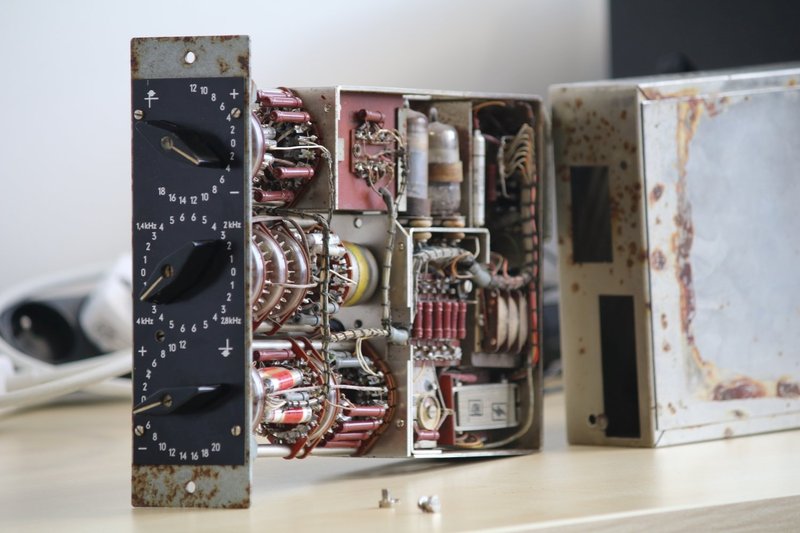
The RZ062 Equalizers were originally (in the 1960s) designed in Germany for installation in mixing consoles. They were supposed to permit arbitrary modification of frequency response in sound recording and reproduction in order to eliminate undesired studio acoustics, noise, or to produce certain acoustic impression or tonal colouring. Soon they accommodated in top European studios. Now, these 6lbs 300V powered units are extremely rare. Due to their inaccessibility and unmistakable sound, their price climbs over $12.000 per pair. But thanks to our precise circuit modeling technique, these jewels can return to your projects.
Common EQ vs RZ062
Nowadays producers tend to surf through various frequencies and spend hours on trying to find the sweet spot of their mix. But the vintage gear worked differently. The RZ062 EQ‘s controls adjust precisely selected fixed parameters. They are perfectly sonically balanced to give the immediate and no compromise results. In addition, the circuitry adds wonderful colour to the entire material.
RZ062a
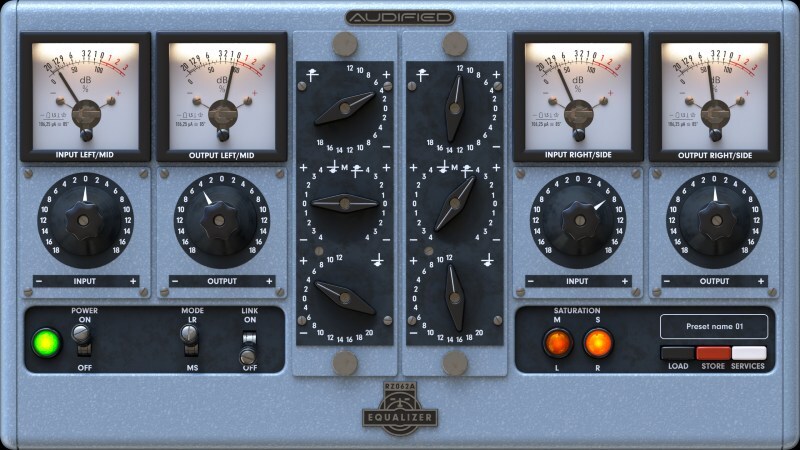
The RZ062a and RZ062b modules differ in the function of the central knob. The a-module middle handle rotates the entire frequency curve by around the central point (650 Hz). When the bass frequencies are raised, the trebles are simultaneously lowered.
RZ062b
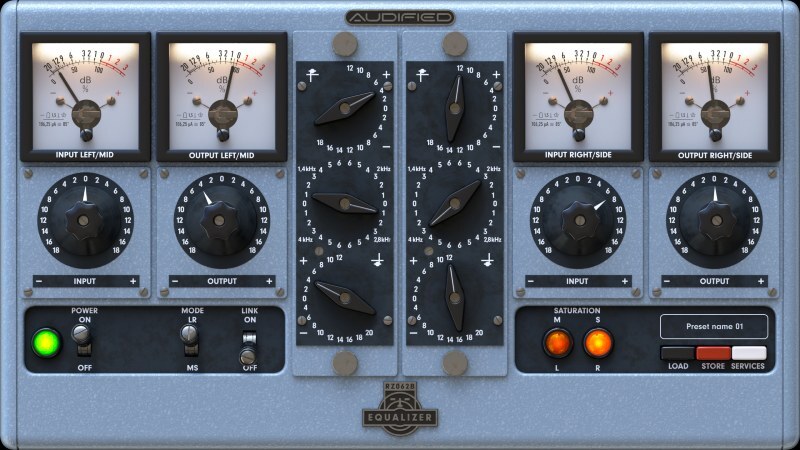
The b-module is even more complicated. Its presence knob lets you choose one of four frequencies (1.4, 2, 2.8 and 4 kHz) and adjust their gain at the same time. This parameter helps your sonic material to cut through very gently and sensitively.
The Model
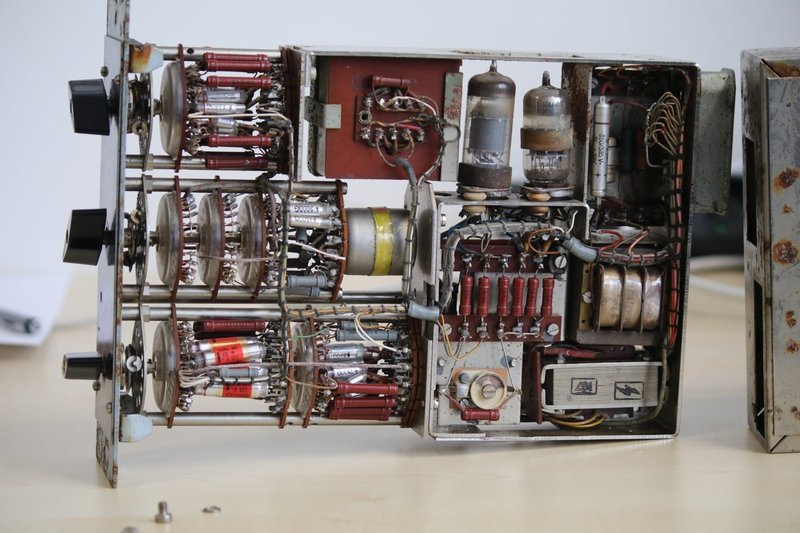
To create these amazing plugins we had to emulate more than 200 circuit components. That includes 3 triodes, input and output transformers. It is not just any circuit but someone did a great job focusing on the details. Each part has its own thoughtful meaning. For RZ062 we used so called white box modeling. We described the whole circuit with complex math equations based on the circuit analysis. Eventually, the overall model was fine tuned by measurements and component-values fitting algorithm. to find as the closest model to the real device as possible.
In Use
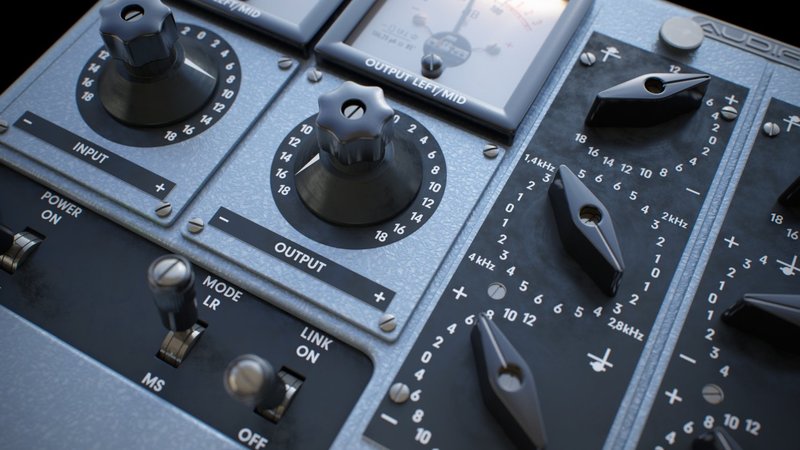
"RZ062‘s place is everywhere where extra bass, treble or presence is needed while improving the overall colour, smoothness, and tightness of the sonic material. RZ062 is incredible on vocals, bass or acoustic instruments.
But due to the advanced controls – the independent left/right channels tweaking or mid/side operation - the main point of the RZ062 EQs is the top quality mastering purpose."
Features:
- 2 EQ Plugins in a Bundle
- Precise Valve Circuit Models
- Left/Right and Mid/Side Controls and transformation
- Calibration
- Input and Output Level Control
- Auto Output Parameter (Link)
- Smoothest EQ Sound Available
Video
Rating
Mac OS X:
- Mac OS X 10.11 - macOS 11 (64-bit only) (M1 Apple Silicon compatible)
Plugin Formats for Mac:
- AAX for Pro Tools
- Audio Units (AU)
- VST3
Please Note: VST2 Format is no longer available.
PC:
- Windows 7 - Windows 10
Plugin Formats for PC:
- AAX for Pro Tools (64-bit)
- VST3 (32 / 64-bit)
Please Note: VST2 Format is no longer available.
Important Note: U78 Saturator is iLok protected - the USB hardware key is not necessary. Only a FREE iLok Account/License Manager is required, which is available at iLok.com.
Summit Audio EQF-100
EQ by Softube
Images
Description
![]()
The Summit Audio EQF-100 Full Range Passive Tube Equalizer really sets the standard for all passive equalizer designs. It is a highly versatile and sweet sounding equalizer that will solve most of the tonality issues you may experience in a mix. The EQF-100 is equally suitable for separate tracks as across subgroups or the entire stereo buss.
![]()
Flexibility and smoothness are the key features of this tube driven passive equalizer. Here's finally an equalizer you can use in your DAW to boost frequencies and not limit yourself to cutting. Four fully parametric bands of equalization plus low and high cut filters with three selectable cutoff frequencies each make the EQF-100 a go-to equalizer for any sound or instrument in your mix. A mix that no doubt will sound warmer and fatter with the help of the EQF-100 and its unique blend of tube and solid state technology. If you want more edge from your EQ, just drive the output meter into the red and you'll experience a woody and thick saturation coming from the output stage.
Video
Rating
- Mac OS X 10.12 or newer (older OS versions may work but are not tested (64-bit only).
- Windows 64-bit, versions 7, 8 or 10 (64-bit only).
- Intel Core 2 Duo, AMD Athlon 64 X2 or newer.
- Screen resolution 1280x800 or larger.
- Supported sample rates: 44.1, 48, 88.2, 96, 176.4 and 192 kHz, in both mono and stereo.
- 8 GB RAM or more is recommended, as well as at least 8 GB hard disk space for installation (individual plug-ins take less space, while sample libraries may require additional disk space).
- A Softube account is required to register and install the software.
- An iLok account is required for authorisation of the software.
- Internet access for downloading installer and managing licenses.
- iLok generation 2 and up, if you intend to use a physical iLok dongle for authorizing your plug-ins (note that an iLok dongle is not a requirement).
- In theory, any 64-bit VST, VST3, AU, or AAX (11.0.2 or higher) compatible host application should work.
- The most recent maintenance release of the DAW application is recommended.
However, due to plug-in host differences between DAWs - and our own rigorous testing standards - we only officially test our plug-ins and instruments in the most recent versions of Pro Tools, Logic Pro, Cubase, Live, Studio One, Digital Performer, Reaper and Sonar. Softube plugins are not tested in the non-listed systems, but they most likely work as long as the system requirements are met. We cannot guarantee a solution for issues in unsupported systems.
Important note: make sure that you always use the latest iLok License Manager. It is not included in the Softube installer but can be downloaded from www.ilok.com

The Summit Audio EQF-100 Full Range Passive Tube Equalizer really sets the standard for all passive equalizer designs. It is a highly versatile and sweet sounding equalizer that will solve most of the tonality issues you may experience in a mix. The EQF-100 is equally suitable for separate tracks as across subgroups or the entire stereo buss.
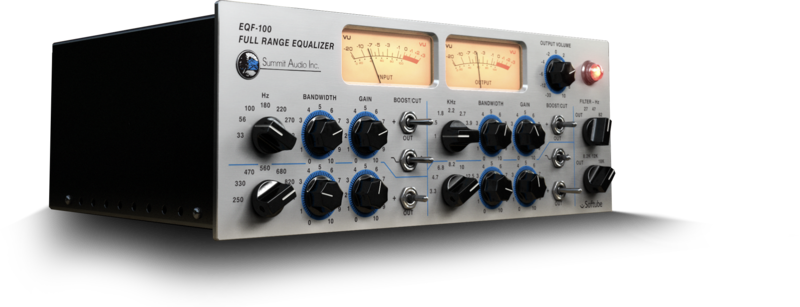
Flexibility and smoothness are the key features of this tube driven passive equalizer. Here's finally an equalizer you can use in your DAW to boost frequencies and not limit yourself to cutting. Four fully parametric bands of equalization plus low and high cut filters with three selectable cutoff frequencies each make the EQF-100 a go-to equalizer for any sound or instrument in your mix. A mix that no doubt will sound warmer and fatter with the help of the EQF-100 and its unique blend of tube and solid state technology. If you want more edge from your EQ, just drive the output meter into the red and you'll experience a woody and thick saturation coming from the output stage.
Video
Rating
- Mac OS X 10.12 or newer (older OS versions may work but are not tested (64-bit only).
- Windows 64-bit, versions 7, 8 or 10 (64-bit only).
- Intel Core 2 Duo, AMD Athlon 64 X2 or newer.
- Screen resolution 1280x800 or larger.
- Supported sample rates: 44.1, 48, 88.2, 96, 176.4 and 192 kHz, in both mono and stereo.
- 8 GB RAM or more is recommended, as well as at least 8 GB hard disk space for installation (individual plug-ins take less space, while sample libraries may require additional disk space).
- A Softube account is required to register and install the software.
- An iLok account is required for authorisation of the software.
- Internet access for downloading installer and managing licenses.
- iLok generation 2 and up, if you intend to use a physical iLok dongle for authorizing your plug-ins (note that an iLok dongle is not a requirement).
- In theory, any 64-bit VST, VST3, AU, or AAX (11.0.2 or higher) compatible host application should work.
- The most recent maintenance release of the DAW application is recommended.
However, due to plug-in host differences between DAWs - and our own rigorous testing standards - we only officially test our plug-ins and instruments in the most recent versions of Pro Tools, Logic Pro, Cubase, Live, Studio One, Digital Performer, Reaper and Sonar. Softube plugins are not tested in the non-listed systems, but they most likely work as long as the system requirements are met. We cannot guarantee a solution for issues in unsupported systems.
Important note: make sure that you always use the latest iLok License Manager. It is not included in the Softube installer but can be downloaded from www.ilok.com
Tube-Tech Equalizer Collection
EQ by Softube
Images
Description
Timeless Equalizers Revitalized
Fat, tube-driven, passive equalizers can be so much more than functional tools. They impart character and style to any source; drums, synths, vocals, guitars, strings, brass… you name it! As such, they’ve been sought after in top-of-the-line international studios for decades, and their sound enriches the textures of thousands of classic records, in every genre you can imagine.
Now combined into a single plug-in, which not only improves the workflow but allows for a revitalized approach to the sonics using Softube's latest digital signal processing technology, the Tube-Tech Equalizers Mk II are a huge step forward for an already phenomenal pair of processors.
By combining the PE 1C and ME 1B equalizers, Softube have made a new beast which benefits from Softube's latest signal-processing technology. Sound engineers all over the world praise the 'Pultec' tube-driven passive equalizer PE 1C for its super huge bass and its silky shiny treble. The all-new high-res graphics look absolutely stunning on any display.
Long and Happy Partnership
As long ago as 2006, Softube formed a partnership with Tube-Tech of Lydkraft, Denmark, and began work on what would become the definitive plug-in representations of Tube-Tech’s best and most highly-prized analogue hardware units.
In 2018 Softube released the updated Mk II versions; a total ground-up remodel of the CL 1B compressor, and a single combined EQ plug-in, taking advantage of Softube's latest signal processing technology. Softube also added stunning high-resolution graphics and additional features to make the best even better.
![]()
Much More Than Function
Fat, tube-driven, passive equalizers can be so much more than functional tools. They impart character and style to any source; drums, synths, vocals, guitars, strings, brass… you name it! As such, they’ve been sought after in top-of-the-line international studios for decades, and their sound enriches the textures of thousands of classic records, in every genre you can imagine.
![]()
Quite a Few Tricks Up Its Sleeves
Try, for example, the famous 'Pultec' low-end trick. Because the filters for the low-frequency boost and attenuate functions are slightly offset in frequency (despite being controlled by the same frequency knob) it’s possible to create attractive and well-focused bumps or cuts in the low end by boosting and attenuating simultaneously. Give a kick drum more body, for example, by boosting heavily at 60 CPS and then attenuating to deal with the muddiness. The bump will remain, but you’ll have cleaned up too.
![]()
Unmatchable Together
The ME 1B was designed to accompany the PE 1C equalizer, and provide control over the frequencies that the PE 1C cannot adjust. On its own it's a great tool to shape the midrange of any audio material, and together with the PE 1C it becomes a versatile and full-featured equalizer.
![]()
Straightforward Interface
The user interface of the ME 1B is pretty straightforward. You have three different sections, the Low-Frequency Peak, Mid Frequency Dip and the High-Frequency Peak. The only confusing thing is that the midsection never boosts, but always attenuates the selected frequency. The other two sections, low and high frequency, always boost the frequencies. But as soon as you start to use the ME 1B in conjunction with the Tube-Tech PE 1C 'Pultec' Equalizer you'll find that these equalizers complement each other perfectly.
![]()
Video
Rating
- Mac OS X 10.13 or newer (older OS versions will not work) (64-bit only).
- Windows 10 64-bit (older Windows versions may work but are not tested) (64-bit only).
- Mac: Intel Core i3 / i5 / i7 / Xeon - M1 support pending.
- Windows: Intel Core i3 / i5 / i7 / Xeon / AMD Quad-Core or newer.
- Screen resolution 1280x800 or larger.
- Supported sample rates: 44.1, 48, 88.2, 96, 176.4 and 192 kHz, in both mono and stereo.
- 8 GB RAM or more is recommended, as well as at least 8 GB hard disk space for installation (individual plug-ins take less space, while sample libraries may require additional disk space).
- A Softube account is required to register and install the software.
- An iLok account is required for authorisation of the software.
- Internet access for downloading installer and managing licenses.
- iLok generation 2 and up, if you intend to use a physical iLok dongle for authorizing your plug-ins (note that an iLok dongle is not a requirement).
- In theory, any 64-bit VST, VST3, AU, or AAX (11.0.2 or higher) compatible host application should work.
- The most recent maintenance release of the DAW application is recommended.
However, due to plug-in host differences between DAWs - and Softube's own rigorous testing standards - Softube only officially test their plug-ins and instruments in the most recent versions of Pro Tools, Logic Pro, Cubase, Live, Studio One, Digital Performer, Reaper and Sonar. Softube plugins are not tested in the non-listed systems, but they most likely work as long as the system requirements are met.
Important note: make sure that you always use the latest iLok License Manager. It is not included in the Softube installer but can be downloaded from www.ilok.com
Timeless Equalizers Revitalized
Fat, tube-driven, passive equalizers can be so much more than functional tools. They impart character and style to any source; drums, synths, vocals, guitars, strings, brass… you name it! As such, they’ve been sought after in top-of-the-line international studios for decades, and their sound enriches the textures of thousands of classic records, in every genre you can imagine.
Now combined into a single plug-in, which not only improves the workflow but allows for a revitalized approach to the sonics using Softube's latest digital signal processing technology, the Tube-Tech Equalizers Mk II are a huge step forward for an already phenomenal pair of processors.
By combining the PE 1C and ME 1B equalizers, Softube have made a new beast which benefits from Softube's latest signal-processing technology. Sound engineers all over the world praise the 'Pultec' tube-driven passive equalizer PE 1C for its super huge bass and its silky shiny treble. The all-new high-res graphics look absolutely stunning on any display.
Long and Happy Partnership
As long ago as 2006, Softube formed a partnership with Tube-Tech of Lydkraft, Denmark, and began work on what would become the definitive plug-in representations of Tube-Tech’s best and most highly-prized analogue hardware units.
In 2018 Softube released the updated Mk II versions; a total ground-up remodel of the CL 1B compressor, and a single combined EQ plug-in, taking advantage of Softube's latest signal processing technology. Softube also added stunning high-resolution graphics and additional features to make the best even better.
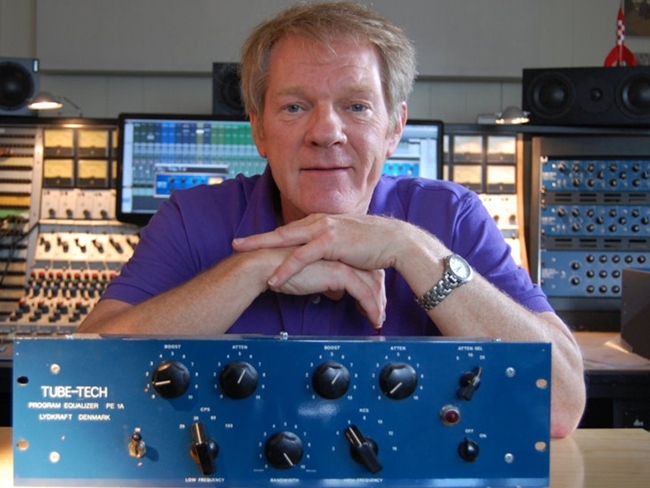
Much More Than Function
Fat, tube-driven, passive equalizers can be so much more than functional tools. They impart character and style to any source; drums, synths, vocals, guitars, strings, brass… you name it! As such, they’ve been sought after in top-of-the-line international studios for decades, and their sound enriches the textures of thousands of classic records, in every genre you can imagine.
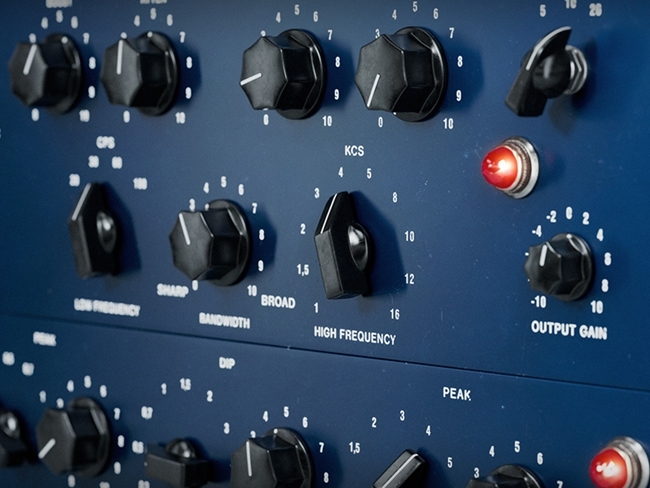
Quite a Few Tricks Up Its Sleeves
Try, for example, the famous 'Pultec' low-end trick. Because the filters for the low-frequency boost and attenuate functions are slightly offset in frequency (despite being controlled by the same frequency knob) it’s possible to create attractive and well-focused bumps or cuts in the low end by boosting and attenuating simultaneously. Give a kick drum more body, for example, by boosting heavily at 60 CPS and then attenuating to deal with the muddiness. The bump will remain, but you’ll have cleaned up too.
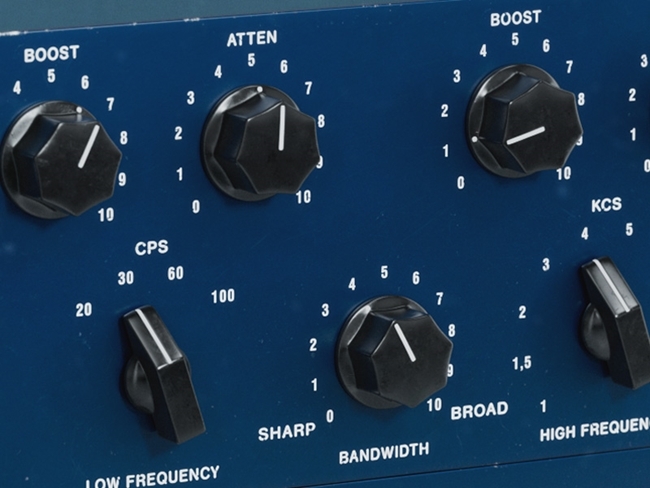
Unmatchable Together
The ME 1B was designed to accompany the PE 1C equalizer, and provide control over the frequencies that the PE 1C cannot adjust. On its own it's a great tool to shape the midrange of any audio material, and together with the PE 1C it becomes a versatile and full-featured equalizer.
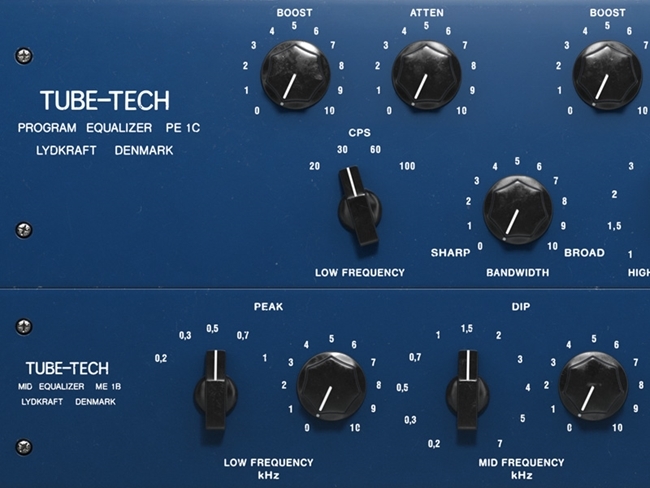
Straightforward Interface
The user interface of the ME 1B is pretty straightforward. You have three different sections, the Low-Frequency Peak, Mid Frequency Dip and the High-Frequency Peak. The only confusing thing is that the midsection never boosts, but always attenuates the selected frequency. The other two sections, low and high frequency, always boost the frequencies. But as soon as you start to use the ME 1B in conjunction with the Tube-Tech PE 1C 'Pultec' Equalizer you'll find that these equalizers complement each other perfectly.
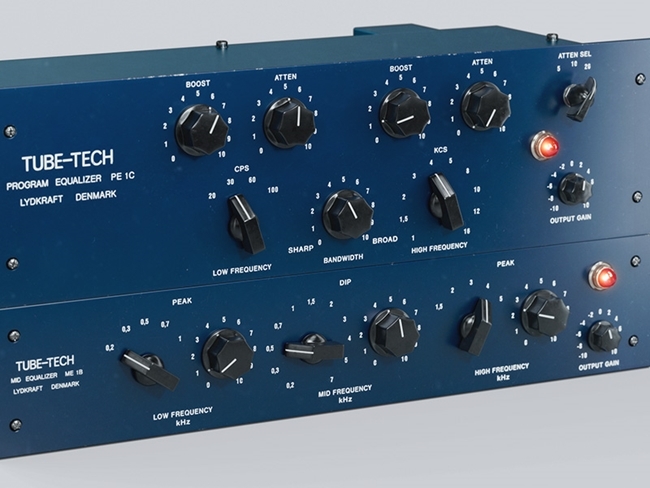
Video
Rating
- Mac OS X 10.13 or newer (older OS versions will not work) (64-bit only).
- Windows 10 64-bit (older Windows versions may work but are not tested) (64-bit only).
- Mac: Intel Core i3 / i5 / i7 / Xeon - M1 support pending.
- Windows: Intel Core i3 / i5 / i7 / Xeon / AMD Quad-Core or newer.
- Screen resolution 1280x800 or larger.
- Supported sample rates: 44.1, 48, 88.2, 96, 176.4 and 192 kHz, in both mono and stereo.
- 8 GB RAM or more is recommended, as well as at least 8 GB hard disk space for installation (individual plug-ins take less space, while sample libraries may require additional disk space).
- A Softube account is required to register and install the software.
- An iLok account is required for authorisation of the software.
- Internet access for downloading installer and managing licenses.
- iLok generation 2 and up, if you intend to use a physical iLok dongle for authorizing your plug-ins (note that an iLok dongle is not a requirement).
- In theory, any 64-bit VST, VST3, AU, or AAX (11.0.2 or higher) compatible host application should work.
- The most recent maintenance release of the DAW application is recommended.
However, due to plug-in host differences between DAWs - and Softube's own rigorous testing standards - Softube only officially test their plug-ins and instruments in the most recent versions of Pro Tools, Logic Pro, Cubase, Live, Studio One, Digital Performer, Reaper and Sonar. Softube plugins are not tested in the non-listed systems, but they most likely work as long as the system requirements are met.
Important note: make sure that you always use the latest iLok License Manager. It is not included in the Softube installer but can be downloaded from www.ilok.com
Trident A-Range
EQ by Softube
Images
Description
![]()
The Trident A-Range equalizer is a legendary piece of equipment. As only thirteen A-Range consoles were ever made, it remains a holy grail for sound engineers and producers around the world that hope to create works of art equal to those that were originally recorded on the A-Range - David Bowie's Ziggy Stardust, Queen, Elton John, the list goes on...
It is sometimes said that one of the disadvantages of digital mixing and recording is that the happy accidents one could experience with analog gear just don't happen in the DAW. People saying that clearly haven't tried Softube's Trident A-Range equalizer.
Because the Trident A-Range is not only a tremendously nice sounding and highly characteristic equalizer. Its four frequency bands also have a way of integrating in sometimes rather unpredictable ways. More often than not you will find that the equalizer ends up giving you something even better than you may have expected when you made a certain setting. In this sense, the Trident A-Range is more of a musical instrument than a strictly scientific tool. We think this is one of the major reasons it has been used on so many great classic rock albums and why it's still one of the most coveted pieces of audio equipment around.
Only thirteen A-Range consoles were ever built, and the Softube plug-in version is a very exact model of channel 15 of the Trident A-Range at Sweet Silence Studio 'B' in Denmark. This is producer Flemming Rasmussen's favorite channel for recording lead vocals. Flemming also used it for the solo and rhythm guitars on Metallica's "Ride The Lightning" and "Master of Puppets", as well as Ritchie Blackmore's guitar on the Rainbow albums "Difficult to Cure" and "Bent out of Shape".
![]()
The A-Range channel features four bands of equalization plus high and low pass filters. By driving the console hot, it is possible to get it to distort with a hairy and effective saturation that is just right in some situations, and just wrong in others! We added a separate Saturation control to let you choose easily. Turn it down for clean (and less CPU draw), and up for the sound of a Trident A-Range hard at work.
Only thirteen A-Range consoles were ever built, and the Softube plug-in version is a very exact model of channel 15 of the Trident A-Range at Sweet Silence Studio 'B' in Denmark. This is producer Flemming Rasmussen's favorite channel for recording lead vocals. Flemming also used it for the solo and rhythm guitars on Metallica's "Ride The Lightning" and "Master of Puppets", as well as Ritchie Blackmore's guitar on the Rainbow albums "Difficult to Cure" and "Bent out of Shape".
The A-Range channel features four bands of equalization plus high and low pass filters. By driving the console hot, it is possible to get it to distort with a hairy and effective saturation that is just right in some situations, and just wrong in others! We added a separate Saturation control to let you choose easily. Turn it down for clean (and less CPU draw), and up for the sound of a Trident A-Range hard at work.
Features:
- EQ with a will of its own
- Created together with original designer Professor Malcolm Toft
- Each and every component carefully modeled
- Saturation control
- Very CPU friendly
Video
Rating
- Mac OS X 10.13 or newer (older OS versions will not work) (64-bit only).
- Windows 10 64-bit (older Windows versions may work but are not tested) (64-bit only).
- Mac: Intel Core i3 / i5 / i7 / Xeon - M1 support pending.
- Windows: Intel Core i3 / i5 / i7 / Xeon / AMD Quad-Core or newer.
- Screen resolution 1280x800 or larger.
- Supported sample rates: 44.1, 48, 88.2, 96, 176.4 and 192 kHz, in both mono and stereo.
- 8 GB RAM or more is recommended, as well as at least 8 GB hard disk space for installation (individual plug-ins take less space, while sample libraries may require additional disk space).
- A Softube account is required to register and install the software.
- An iLok account is required for authorisation of the software.
- Internet access for downloading installer and managing licenses.
- iLok generation 2 and up, if you intend to use a physical iLok dongle for authorizing your plug-ins (note that an iLok dongle is not a requirement).
- In theory, any 64-bit VST, VST3, AU, or AAX (11.0.2 or higher) compatible host application should work.
- The most recent maintenance release of the DAW application is recommended.
However, due to plug-in host differences between DAWs - and Softube's own rigorous testing standards - Softube only officially test their plug-ins and instruments in the most recent versions of Pro Tools, Logic Pro, Cubase, Live, Studio One, Digital Performer, Reaper and Sonar. Softube plugins are not tested in the non-listed systems, but they most likely work as long as the system requirements are met.
Important note: make sure that you always use the latest iLok License Manager. It is not included in the Softube installer but can be downloaded from www.ilok.com

The Trident A-Range equalizer is a legendary piece of equipment. As only thirteen A-Range consoles were ever made, it remains a holy grail for sound engineers and producers around the world that hope to create works of art equal to those that were originally recorded on the A-Range - David Bowie's Ziggy Stardust, Queen, Elton John, the list goes on...
It is sometimes said that one of the disadvantages of digital mixing and recording is that the happy accidents one could experience with analog gear just don't happen in the DAW. People saying that clearly haven't tried Softube's Trident A-Range equalizer.
Because the Trident A-Range is not only a tremendously nice sounding and highly characteristic equalizer. Its four frequency bands also have a way of integrating in sometimes rather unpredictable ways. More often than not you will find that the equalizer ends up giving you something even better than you may have expected when you made a certain setting. In this sense, the Trident A-Range is more of a musical instrument than a strictly scientific tool. We think this is one of the major reasons it has been used on so many great classic rock albums and why it's still one of the most coveted pieces of audio equipment around.
Only thirteen A-Range consoles were ever built, and the Softube plug-in version is a very exact model of channel 15 of the Trident A-Range at Sweet Silence Studio 'B' in Denmark. This is producer Flemming Rasmussen's favorite channel for recording lead vocals. Flemming also used it for the solo and rhythm guitars on Metallica's "Ride The Lightning" and "Master of Puppets", as well as Ritchie Blackmore's guitar on the Rainbow albums "Difficult to Cure" and "Bent out of Shape".
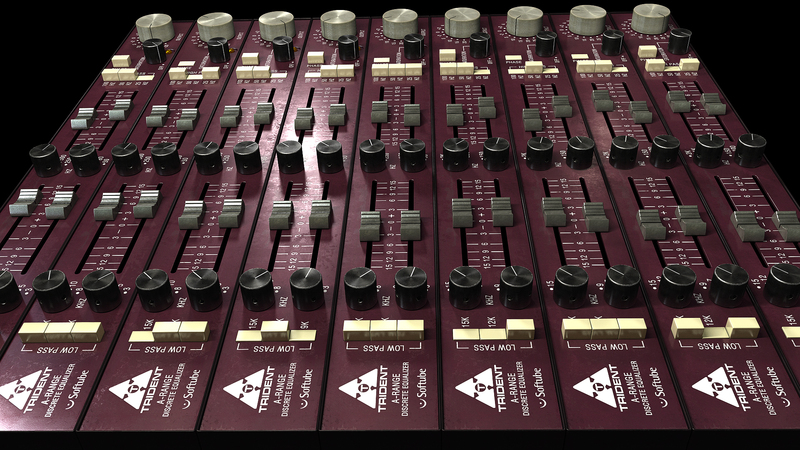
The A-Range channel features four bands of equalization plus high and low pass filters. By driving the console hot, it is possible to get it to distort with a hairy and effective saturation that is just right in some situations, and just wrong in others! We added a separate Saturation control to let you choose easily. Turn it down for clean (and less CPU draw), and up for the sound of a Trident A-Range hard at work.
Only thirteen A-Range consoles were ever built, and the Softube plug-in version is a very exact model of channel 15 of the Trident A-Range at Sweet Silence Studio 'B' in Denmark. This is producer Flemming Rasmussen's favorite channel for recording lead vocals. Flemming also used it for the solo and rhythm guitars on Metallica's "Ride The Lightning" and "Master of Puppets", as well as Ritchie Blackmore's guitar on the Rainbow albums "Difficult to Cure" and "Bent out of Shape".
The A-Range channel features four bands of equalization plus high and low pass filters. By driving the console hot, it is possible to get it to distort with a hairy and effective saturation that is just right in some situations, and just wrong in others! We added a separate Saturation control to let you choose easily. Turn it down for clean (and less CPU draw), and up for the sound of a Trident A-Range hard at work.
Features:
- EQ with a will of its own
- Created together with original designer Professor Malcolm Toft
- Each and every component carefully modeled
- Saturation control
- Very CPU friendly
Video
Rating
- Mac OS X 10.13 or newer (older OS versions will not work) (64-bit only).
- Windows 10 64-bit (older Windows versions may work but are not tested) (64-bit only).
- Mac: Intel Core i3 / i5 / i7 / Xeon - M1 support pending.
- Windows: Intel Core i3 / i5 / i7 / Xeon / AMD Quad-Core or newer.
- Screen resolution 1280x800 or larger.
- Supported sample rates: 44.1, 48, 88.2, 96, 176.4 and 192 kHz, in both mono and stereo.
- 8 GB RAM or more is recommended, as well as at least 8 GB hard disk space for installation (individual plug-ins take less space, while sample libraries may require additional disk space).
- A Softube account is required to register and install the software.
- An iLok account is required for authorisation of the software.
- Internet access for downloading installer and managing licenses.
- iLok generation 2 and up, if you intend to use a physical iLok dongle for authorizing your plug-ins (note that an iLok dongle is not a requirement).
- In theory, any 64-bit VST, VST3, AU, or AAX (11.0.2 or higher) compatible host application should work.
- The most recent maintenance release of the DAW application is recommended.
However, due to plug-in host differences between DAWs - and Softube's own rigorous testing standards - Softube only officially test their plug-ins and instruments in the most recent versions of Pro Tools, Logic Pro, Cubase, Live, Studio One, Digital Performer, Reaper and Sonar. Softube plugins are not tested in the non-listed systems, but they most likely work as long as the system requirements are met.
Important note: make sure that you always use the latest iLok License Manager. It is not included in the Softube installer but can be downloaded from www.ilok.com
SantaCruzEQ6
EQ by MAAT
Images
Description
SantaCruzEQ6
6 precision variations on “analog,” all in one affordable EQ.
Beautiful analog Architectures, up to six, that will ramp up your reputation.
Yes, Your Blueness
Why develop yet one more minimum phase parametric equalizer (PEQ) when there’s already hundreds on the market? The answer is simple…’ Cuz there was room for improvement! It was customers of the original LinearPhase PEQ Red and Orange who asked Algorithmix to develop a classic EQ, for recording and mixing tasks, with unparalleled purity and transparency. Over several years, Dr Christoph closely analyzed many of the best out there and compiled a vast knowledge base of analogue EQ best practices. Cherry-picking from that, he implemented not just one or two, but an entire collection of trad minimal phase EQs. The result? A distillation of analogue antecedents, while others are based on new ideas. You're sure to enjoy these six variations of blue, newly revised by MAAT, and find your favourite sound.
The Not So Dirty Half-Dozen
MAAT wanted to lift analogue to another level, so they reverse-engineered a variety of well-respected hardware EQs, creating idealized digital versions from that inspiration. Rather than models or simulations that carry analogue baggage, SantaCruzEQ has no noise, distortion or other secondary effects inherited from analogue.
SantaCruzEQ6 is the most complete collection of classic equalizer architectures ever assembled into one package. You get precise, idealized examples of legendary analogue equalizer circuitry, complemented by progressive new models. Whether it’s vintage, modern, or experimental, SantaCruzEQ is a sonic sandbox for every mixing and mastering engineer to mess around in.
![]()
BFF
The equalizer is perhaps the oldest and the most popular of sound processing tools. From its earliest days, the main function was correction or enhancement by boosting or cutting certain frequencies.
For a century, engineers have developed countless equalizers. A few became legends, MAAT's thEQorange is one. The most popular version in recording and post is the parametric equalizer or PEQ, first perfected by Massenburg in 1972. It offers maximum flexibility with only three controls. Properly used, the PEQ is a powerful tool and the best friend of every audio engineer in the quest for the perfect sound. As Spidey (and Voltaire) always reminds us though, “With great power comes great responsibility.” When designed by a clueless or cost-constrained software engineer, it can be your greatest sonic enemy.
Choice Is Good
SantaCruzEQ6, with 6 architectures; all six below:
- Classic Sym Series symmetrical, almost constant Q bell — common mix desk & outboard gear topology, try on “surgical” applications
- Classic Asym Series asymmetrical — Old Skool, boost like № 1 but with narrower cut
- Proportional 1 Series proportional — More musical than constant Q, especially for mixing and post. Bells are wider at <6dB and narrower at >6dB
- Proportional 2 Series proportional — Like 03 but with bigger changes at large gain settings > ±6dB, try on vocals
- Proportional 3 Series proportional — Like 03 but with extra-wide bells at small gain settings, from 0 to 3dB
- Const-Q Asym Series asymmetrical, constant Q — Boost like № 1, cut like № 5 (extra wide), as found in some USA products & mixers
Constant Q is more for surgical applications, while proportional EQs are best when combining multiple overlapping Sections. As a point of reference, API, Pultec, Masselec and Avalon EQs are all of the proportional type. Note that all 6 topologies are normalized to have exactly the same bell shape at 6dB of boost. This allows you to easily compare the sound of each architecture.
Better By Design
SantaCruzEQ is built on the belief that exceptional fidelity, enhanced workflows and less visual fatigue are hallmarks of better quality toolsets. MAAT's reliance on hard science and focused research balanced by in-depth listening and customer feedback redefines audio tools for you and your fellow hardcore media professionals worldwide.
![]()
Rating
Operating Systems
- macOS 10.9 -10.15 (64-bit only)
Windows 7 and newer (32 & 64-bit)
Supported Platforms
- AAX (Pro Tools 10.3.10 and newer)
- AU, VST 2, VST 3
- Sample rates from 44.1 to 384 kHz
SantaCruzEQ6
6 precision variations on “analog,” all in one affordable EQ.
Beautiful analog Architectures, up to six, that will ramp up your reputation.
Yes, Your Blueness
Why develop yet one more minimum phase parametric equalizer (PEQ) when there’s already hundreds on the market? The answer is simple…’ Cuz there was room for improvement! It was customers of the original LinearPhase PEQ Red and Orange who asked Algorithmix to develop a classic EQ, for recording and mixing tasks, with unparalleled purity and transparency. Over several years, Dr Christoph closely analyzed many of the best out there and compiled a vast knowledge base of analogue EQ best practices. Cherry-picking from that, he implemented not just one or two, but an entire collection of trad minimal phase EQs. The result? A distillation of analogue antecedents, while others are based on new ideas. You're sure to enjoy these six variations of blue, newly revised by MAAT, and find your favourite sound.
The Not So Dirty Half-Dozen
MAAT wanted to lift analogue to another level, so they reverse-engineered a variety of well-respected hardware EQs, creating idealized digital versions from that inspiration. Rather than models or simulations that carry analogue baggage, SantaCruzEQ has no noise, distortion or other secondary effects inherited from analogue.
SantaCruzEQ6 is the most complete collection of classic equalizer architectures ever assembled into one package. You get precise, idealized examples of legendary analogue equalizer circuitry, complemented by progressive new models. Whether it’s vintage, modern, or experimental, SantaCruzEQ is a sonic sandbox for every mixing and mastering engineer to mess around in.
BFF
The equalizer is perhaps the oldest and the most popular of sound processing tools. From its earliest days, the main function was correction or enhancement by boosting or cutting certain frequencies.
For a century, engineers have developed countless equalizers. A few became legends, MAAT's thEQorange is one. The most popular version in recording and post is the parametric equalizer or PEQ, first perfected by Massenburg in 1972. It offers maximum flexibility with only three controls. Properly used, the PEQ is a powerful tool and the best friend of every audio engineer in the quest for the perfect sound. As Spidey (and Voltaire) always reminds us though, “With great power comes great responsibility.” When designed by a clueless or cost-constrained software engineer, it can be your greatest sonic enemy.
Choice Is Good
SantaCruzEQ6, with 6 architectures; all six below:
- Classic Sym Series symmetrical, almost constant Q bell — common mix desk & outboard gear topology, try on “surgical” applications
- Classic Asym Series asymmetrical — Old Skool, boost like № 1 but with narrower cut
- Proportional 1 Series proportional — More musical than constant Q, especially for mixing and post. Bells are wider at <6dB and narrower at >6dB
- Proportional 2 Series proportional — Like 03 but with bigger changes at large gain settings > ±6dB, try on vocals
- Proportional 3 Series proportional — Like 03 but with extra-wide bells at small gain settings, from 0 to 3dB
- Const-Q Asym Series asymmetrical, constant Q — Boost like № 1, cut like № 5 (extra wide), as found in some USA products & mixers
Constant Q is more for surgical applications, while proportional EQs are best when combining multiple overlapping Sections. As a point of reference, API, Pultec, Masselec and Avalon EQs are all of the proportional type. Note that all 6 topologies are normalized to have exactly the same bell shape at 6dB of boost. This allows you to easily compare the sound of each architecture.
Better By Design
SantaCruzEQ is built on the belief that exceptional fidelity, enhanced workflows and less visual fatigue are hallmarks of better quality toolsets. MAAT's reliance on hard science and focused research balanced by in-depth listening and customer feedback redefines audio tools for you and your fellow hardcore media professionals worldwide.
Rating
Operating Systems
- macOS 10.9 -10.15 (64-bit only)
Windows 7 and newer (32 & 64-bit)
Supported Platforms
- AAX (Pro Tools 10.3.10 and newer)
- AU, VST 2, VST 3
- Sample rates from 44.1 to 384 kHz
FabFilter Pro-Q 3
EQ by FabFilter
Images
Description
Highest possible sound quality, unrivalled interface workflow
Upgrade Note: Pro-Q 2 users can Upgrade to v3.
Unrivalled Sound and Workflow
An equalizer is probably the tool you use most while mixing and mastering, so you need the best of the best! With FabFilter Pro-Q 3, you get the highest possible sound quality and a gorgeous, innovative interface with unrivalled ease of use.
Mixing and Mastering Features
Pro-Q 2 offers everything that a demanding engineer could wish for: top quality linear phase operation in addition to the zero latency and unique Natural Phase modes, Mid/Side processing, variable stereo placement of EQ bands, an intelligent solo feature, optional Auto Gain and a built-in, fully customizable spectrum analyzer.
![]()
Effortlessly Sculpt Your Sound
FabFilter Pro-Q 3 is designed to help you achieve your sound in the quickest way possible. Via the large interactive EQ display, you can create bands where you need them, enable dynamic EQ for any band, and select and edit multiple bands at once.
Unique features like Spectrum Grab, Full Screen mode and EQ Match will speed up your workflow even more. Try it yourself!
![]()
FabFilter Goodies
Of course, you also get all the usual FabFilter goodies: perfectly tuned knobs, interactive MIDI Learn, undo/redo and A/B switch, Smart Parameter Interpolation for smooth parameter transitions, an extensive help file with interactive help hints, sample-accurate automation, advanced optimization and much more!
![]()
Key features
- Highest possible sound quality
- Up to 24 EQ bands
-
NEW - Optional Dynamic EQ mode for all bands (Bell and Shelf shapes), using any slope setting and with perfect analog matching
-
IMPROVED - Gorgeous Retina interface with large interactive EQ display, multi-band selection and editing for maximum ease of use and efficiency
-
NEW - Ultra-steep 'Brickwall' slope setting for LP and HP filters
-
NEW - Full surround support (up to Dolby Atmos 7.1.2) with intelligent speaker selection
-
NEW - External spectrum visualization from any other Pro-Q 3 instance, including collision detection
-
NEW - Per-band mid/side or left/right processing, so you can EQ the mid, side, left or right signals separately
- Operates in zero latency mode, linear phase mode with adjustable latency or the unique Natural Phase mode
-
NEW - Flat Tilt filter shape, a flat tilting correction curve over the whole audible frequency spectrum
-
IMPROVED - Spectrum Grab: just grab and adjust a peak in the real-time spectrum analyzer right away!
- Different interface sizes and additional Full Screen mode
-
IMPROVED - Filter shapes: Bell, Notch, High/Low Shelf, High/Low Cut, Band Pass, Tilt Shelf, Flat Tilt
- Universal filter slope support for all filter types, up to 96 dB/oct
-
IMPROVED - EQ Match feature to automatically match the spectrum of another Pro-Q 3 instance or an external signal
-
IMPROVED - Built-in spectrum analyzer with Pre-EQ, Post-EQ and external spectrum visualization, adjustable range, speed, resolution, tilt, freeze and collision detection
- Auto Gain and Gain Scale
- Optional piano roll display to quantize EQ frequencies to musical notes
- Different display ranges: 3 dB and 6 dB ranges for mastering, 12 dB and 30 dB for mixing
- Intelligent solo mode makes it easy to find problem frequencies and hear the effect of a band
- Phase Invert option to change polarity
- Large output level meter with peak level readout
- Extreme CPU optimization: Pro-Q 3 uses very little CPU and memory, so you can use hundreds of instances in a session
- GPU-powered graphics acceleration
- Double-click text entry of parameter values
-
IMPROVED - Supports stereo, mono and surround channel layouts (up to Dolby Atmos 7.1.2)
- Supports common Pro Tools hardware control surfaces
-
IMPROVED - MIDI Learn with option to control the currently active band
- Undo/redo and A/B comparison
- Smart Parameter Interpolation
- Sample-accurate automation of all parameters
- Extensive help file with interactive help hints
- Available in VST, VST3, Audio Units, AAX Native and AudioSuite formats (all both 64-bit and 32-bit)
Video
Rating
Windows:
- 64-bit: Windows 10, 8, 7 or Vista
- 32-bit: Windows 10, 8, 7, Vista or XP
- VST 2/3 host or Pro Tools
macOS:
- macOS 10.10 or higher (64-bit only)
- AU or VST 2/3 host or Pro Tools
- Intel or Apple Silicon processor
Plugin Formats:
All FabFilter plug-ins are available in VST, VST3, Audio Units, AAX Native and AudioSuite formats.
Highest possible sound quality, unrivalled interface workflow
Upgrade Note: Pro-Q 2 users can Upgrade to v3.
Unrivalled Sound and Workflow
An equalizer is probably the tool you use most while mixing and mastering, so you need the best of the best! With FabFilter Pro-Q 3, you get the highest possible sound quality and a gorgeous, innovative interface with unrivalled ease of use.
Mixing and Mastering Features
Pro-Q 2 offers everything that a demanding engineer could wish for: top quality linear phase operation in addition to the zero latency and unique Natural Phase modes, Mid/Side processing, variable stereo placement of EQ bands, an intelligent solo feature, optional Auto Gain and a built-in, fully customizable spectrum analyzer.
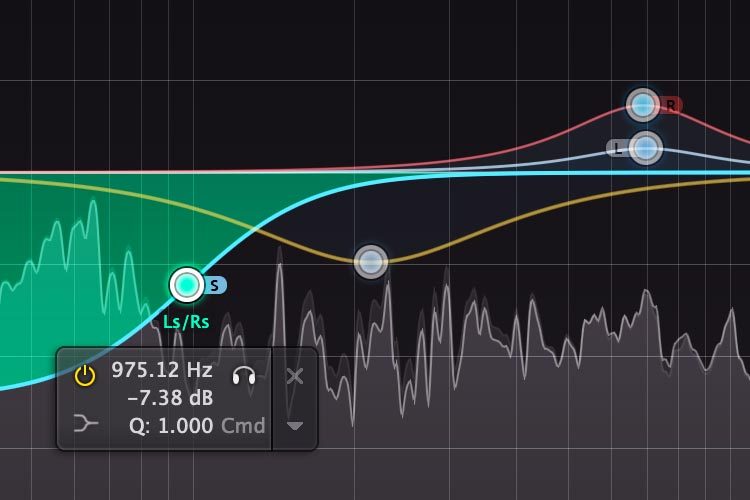
Effortlessly Sculpt Your Sound
FabFilter Pro-Q 3 is designed to help you achieve your sound in the quickest way possible. Via the large interactive EQ display, you can create bands where you need them, enable dynamic EQ for any band, and select and edit multiple bands at once.
Unique features like Spectrum Grab, Full Screen mode and EQ Match will speed up your workflow even more. Try it yourself!
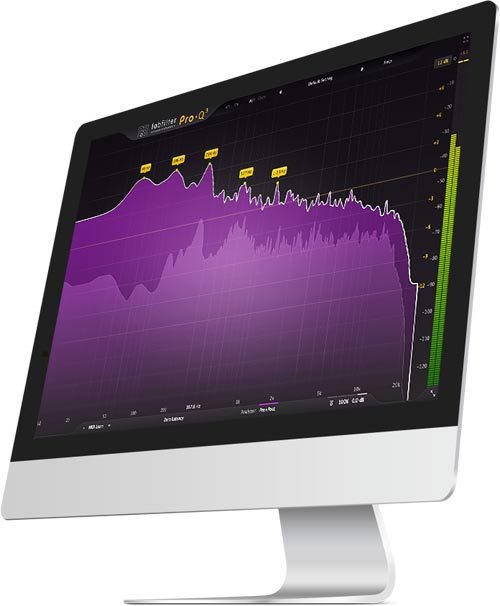
FabFilter Goodies
Of course, you also get all the usual FabFilter goodies: perfectly tuned knobs, interactive MIDI Learn, undo/redo and A/B switch, Smart Parameter Interpolation for smooth parameter transitions, an extensive help file with interactive help hints, sample-accurate automation, advanced optimization and much more!
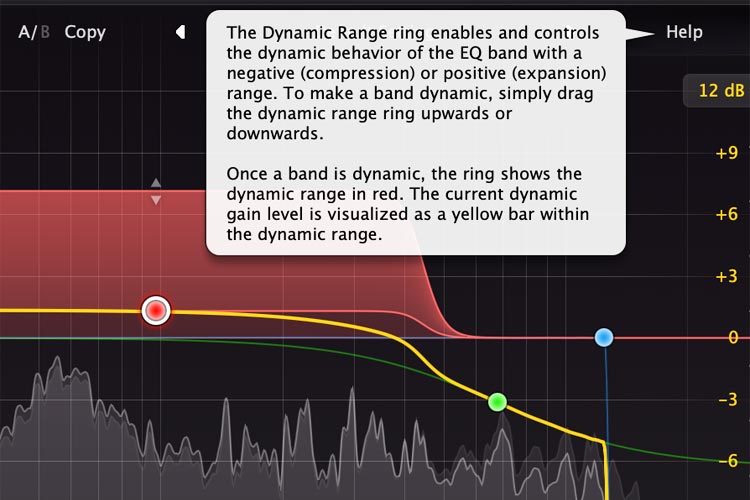
Key features
- Highest possible sound quality
- Up to 24 EQ bands
- NEW - Optional Dynamic EQ mode for all bands (Bell and Shelf shapes), using any slope setting and with perfect analog matching
- IMPROVED - Gorgeous Retina interface with large interactive EQ display, multi-band selection and editing for maximum ease of use and efficiency
- NEW - Ultra-steep 'Brickwall' slope setting for LP and HP filters
- NEW - Full surround support (up to Dolby Atmos 7.1.2) with intelligent speaker selection
- NEW - External spectrum visualization from any other Pro-Q 3 instance, including collision detection
- NEW - Per-band mid/side or left/right processing, so you can EQ the mid, side, left or right signals separately
- Operates in zero latency mode, linear phase mode with adjustable latency or the unique Natural Phase mode
- NEW - Flat Tilt filter shape, a flat tilting correction curve over the whole audible frequency spectrum
- IMPROVED - Spectrum Grab: just grab and adjust a peak in the real-time spectrum analyzer right away!
- Different interface sizes and additional Full Screen mode
- IMPROVED - Filter shapes: Bell, Notch, High/Low Shelf, High/Low Cut, Band Pass, Tilt Shelf, Flat Tilt
- Universal filter slope support for all filter types, up to 96 dB/oct
- IMPROVED - EQ Match feature to automatically match the spectrum of another Pro-Q 3 instance or an external signal
- IMPROVED - Built-in spectrum analyzer with Pre-EQ, Post-EQ and external spectrum visualization, adjustable range, speed, resolution, tilt, freeze and collision detection
- Auto Gain and Gain Scale
- Optional piano roll display to quantize EQ frequencies to musical notes
- Different display ranges: 3 dB and 6 dB ranges for mastering, 12 dB and 30 dB for mixing
- Intelligent solo mode makes it easy to find problem frequencies and hear the effect of a band
- Phase Invert option to change polarity
- Large output level meter with peak level readout
- Extreme CPU optimization: Pro-Q 3 uses very little CPU and memory, so you can use hundreds of instances in a session
- GPU-powered graphics acceleration
- Double-click text entry of parameter values
- IMPROVED - Supports stereo, mono and surround channel layouts (up to Dolby Atmos 7.1.2)
- Supports common Pro Tools hardware control surfaces
- IMPROVED - MIDI Learn with option to control the currently active band
- Undo/redo and A/B comparison
- Smart Parameter Interpolation
- Sample-accurate automation of all parameters
- Extensive help file with interactive help hints
- Available in VST, VST3, Audio Units, AAX Native and AudioSuite formats (all both 64-bit and 32-bit)
Video
Rating
Windows:
- 64-bit: Windows 10, 8, 7 or Vista
- 32-bit: Windows 10, 8, 7, Vista or XP
- VST 2/3 host or Pro Tools
macOS:
- macOS 10.10 or higher (64-bit only)
- AU or VST 2/3 host or Pro Tools
- Intel or Apple Silicon processor
Plugin Formats:
All FabFilter plug-ins are available in VST, VST3, Audio Units, AAX Native and AudioSuite formats.
MTurboEQ
EQ by MeldaProduction
Images
Description
MTurboEQ is a unique vintage-style equalizer inspired by most of the well-known classic hardware. It's not one of them, it's all of them! For quick and easy equalization with pristine results.
Equalization reinvented for easier and faster workflow
MTurboEQ speeds up the workflow tremendously by providing access to so many classic equalizers in a single click. But it doesn't stop there. The controls in each hardware were very different, and very weird in many cases, so one had to take a lot of time learning to work with such a clumsy interface. All models in MTurboEQ have pretty much the same user interface and features. There is always a low-shelf and a high-shelf, the most essential filters. Then there are usually 4 peak filters, even if the original had just one, and they always work the same way. And of course there are the classic goodies such as high-pass and low-pass filters (which are used on pretty much all tracks these days, but not many vintage equalizers actually had them), saturation to get some of the analogue feel, dry/wet for easy control of the amount of equalization, automatic gain compensation to avoid loudness trickery, mid/side/surround and more...
Stepped vs. Continous
Some people just like lots of versatility, others prefer having limited options. MTurboEQ provides both options. In Stepped mode almost everything has limited values - predefined frequencies for each filter, gain increasing by single decibels etc. It is much faster to make a decision this way, especially since bigger differences are easier to compare by ear. And when (if) you are ready, you can just switch to Continous mode for fine-tuning. MTurboEQ then lets you access all of the frequencies etc., even if the original hardware (and all emulations) didn't have that. Courtesy of the digital world.
We did the hard work, you equalize!
There is no doubt, that you could do 99.9999% of the sound of any analog equalizer using a versatile parametric equalizer, such as MAutoDynamicEq. It's just frequencies and curves after all, there's no hidden magic. But the analogue equalizers have one big advantage - the design. They provide access only to what you will likely use, configured in such a way, that it all just sounds good from the beginning. We analyzed these designs, copied what we considered useful, trashed the rest (such as noise, hum, pointless overall gain changes...) and now we serve you a finished equalizer, which you can just plug in, turn a few knobs and you are done. It's fast and the results are great, that's all, no magic.
Rating
Windows
- Windows Vista / 7 / 8 / 10 (32-bit or 64-bit)
- VST / VST3 / AAX compatible host (32-bit or 64-bit)
- Intel/AMD processor with SSE2 support
Always use 32-bit plugins in 32-bit hosts, or 64-bit plugins in 64-bit hosts!
64-bit plugins can't work in 32-bit hosts even if the operating system is 64-bit. Do NOT use 32-bit plugins in 64-bit hosts. They would have to be bridged and can become slow and unstable.
Mac OS X
- Mac OS X 10.9 and newer (64-bit only)
- VST / VST3 / AU / AAX compatible host (64-bit only)
- Intel/AMD processor with SSE2 support or Apple Silicon processor
Note: Please check your product PDF documentation for more information and installation instructions.
MTurboEQ is a unique vintage-style equalizer inspired by most of the well-known classic hardware. It's not one of them, it's all of them! For quick and easy equalization with pristine results.
Equalization reinvented for easier and faster workflow
MTurboEQ speeds up the workflow tremendously by providing access to so many classic equalizers in a single click. But it doesn't stop there. The controls in each hardware were very different, and very weird in many cases, so one had to take a lot of time learning to work with such a clumsy interface. All models in MTurboEQ have pretty much the same user interface and features. There is always a low-shelf and a high-shelf, the most essential filters. Then there are usually 4 peak filters, even if the original had just one, and they always work the same way. And of course there are the classic goodies such as high-pass and low-pass filters (which are used on pretty much all tracks these days, but not many vintage equalizers actually had them), saturation to get some of the analogue feel, dry/wet for easy control of the amount of equalization, automatic gain compensation to avoid loudness trickery, mid/side/surround and more...
Stepped vs. Continous
Some people just like lots of versatility, others prefer having limited options. MTurboEQ provides both options. In Stepped mode almost everything has limited values - predefined frequencies for each filter, gain increasing by single decibels etc. It is much faster to make a decision this way, especially since bigger differences are easier to compare by ear. And when (if) you are ready, you can just switch to Continous mode for fine-tuning. MTurboEQ then lets you access all of the frequencies etc., even if the original hardware (and all emulations) didn't have that. Courtesy of the digital world.
We did the hard work, you equalize!
There is no doubt, that you could do 99.9999% of the sound of any analog equalizer using a versatile parametric equalizer, such as MAutoDynamicEq. It's just frequencies and curves after all, there's no hidden magic. But the analogue equalizers have one big advantage - the design. They provide access only to what you will likely use, configured in such a way, that it all just sounds good from the beginning. We analyzed these designs, copied what we considered useful, trashed the rest (such as noise, hum, pointless overall gain changes...) and now we serve you a finished equalizer, which you can just plug in, turn a few knobs and you are done. It's fast and the results are great, that's all, no magic.
Rating
Windows
- Windows Vista / 7 / 8 / 10 (32-bit or 64-bit)
- VST / VST3 / AAX compatible host (32-bit or 64-bit)
- Intel/AMD processor with SSE2 support
Always use 32-bit plugins in 32-bit hosts, or 64-bit plugins in 64-bit hosts!
64-bit plugins can't work in 32-bit hosts even if the operating system is 64-bit. Do NOT use 32-bit plugins in 64-bit hosts. They would have to be bridged and can become slow and unstable.
Mac OS X
- Mac OS X 10.9 and newer (64-bit only)
- VST / VST3 / AU / AAX compatible host (64-bit only)
- Intel/AMD processor with SSE2 support or Apple Silicon processor
Note: Please check your product PDF documentation for more information and installation instructions.
Passive-Active Pack
EQ by Softube
Images
Description
This Collection Includes Three Highly Useable Equalizer Models that are Unique to Softube
![]()
The Passive-Active Pack is a collection of three very different equalizers, each with its own character and quirks. The Passive and Active equalizers emulate real workhorse units, used on thousands of recordings from past to present. The Focusing Equalizer combines these with analog sounding saturation and a novel workflow.
Passive Equalizer
![]()
Passive Equalizer is modeled from a famous German passive three-band equalizer, and features a wide bandwidth and an unsurpassed clear and open sound. The low boost gives you a warm low end, perfect to fatten up a bass drum or bass guitar track. Cutting the highs gives you a very gentle 6 dB cut which allows you to remove highs in a very musical way. The high boost is open and crisp and breathes life into any track.
Key Features:
- Three bands with an extremely wide and open sound
- Excellent treble control without any "digital harshness"
- Warm low end and a sparkling top
Active Equalizer
![]()
Active Equalizer is modeled from an active equalizer design made somewhere in the Swiss alps in the seventies. Whereas the Passive Equalizer is wide, clear and unintrusive, the Active Equalizer is more of a surgeon with a tight and focused sound. It's a highly useful problem solver when you need to get into details.
Key Features:
- Tight and focused sounding filters
- Low and High cut
- Three parametric bands with selectable gain in 2dB steps (-/+ 16 dB), selectable frequency with overlapping, but non-interfering, bands (50-500 Hz, 380Hz-3.8kHz, 1.8-18kHz) and a choice between a narrow or wide peak (Q) for each band
Focusing Equalizer
![]()
Focusing Equalizer is an inspiring and untraditional take on the EQ concept, which is all made up by Softube. The Focusing Equalizer works in a very musical way and does a lot of thinking for you.
At first glance it may seem like you're sacrificing versatility by using an equalizer with a limited set of options - why use a three-band equalizer when you can use your digital equalizer with umpteen bands, continous gain, selectable Q and different curves all built in? Well, equalization is all about sound design. Having an equalizer where the designer has already made some of the choices four you is like having an experienced sound engineer helping out and giving you directions.
Key Features:
- Inspiring, untraditional and very useful workflow
- Choose between Passive or Active EQ character
- Three-band EQ that automatically and musically changes with Low and High Cut
- Built-in one-knob saturation with metering and selectable saturation type
Video
Rating
- Mac OS X 10.13 or newer (older OS versions will not work) (64-bit only).
- Windows 10 64-bit (older Windows versions may work but are not tested) (64-bit only).
- Mac: Intel Core i3 / i5 / i7 / Xeon - M1 support pending.
- Windows: Intel Core i3 / i5 / i7 / Xeon / AMD Quad-Core or newer.
- Screen resolution 1280x800 or larger.
- Supported sample rates: 44.1, 48, 88.2, 96, 176.4 and 192 kHz, in both mono and stereo.
- 8 GB RAM or more is recommended, as well as at least 8 GB hard disk space for installation (individual plug-ins take less space, while sample libraries may require additional disk space).
- A Softube account is required to register and install the software.
- An iLok account is required for authorisation of the software.
- Internet access for downloading installer and managing licenses.
- iLok generation 2 and up, if you intend to use a physical iLok dongle for authorizing your plug-ins (note that an iLok dongle is not a requirement).
- In theory, any 64-bit VST, VST3, AU, or AAX (11.0.2 or higher) compatible host application should work.
- The most recent maintenance release of the DAW application is recommended.
However, due to plug-in host differences between DAWs - and Softube's own rigorous testing standards - Softube only officially test their plug-ins and instruments in the most recent versions of Pro Tools, Logic Pro, Cubase, Live, Studio One, Digital Performer, Reaper and Sonar. Softube plugins are not tested in the non-listed systems, but they most likely work as long as the system requirements are met.
Important note: make sure that you always use the latest iLok License Manager. It is not included in the Softube installer but can be downloaded from www.ilok.com
This Collection Includes Three Highly Useable Equalizer Models that are Unique to Softube
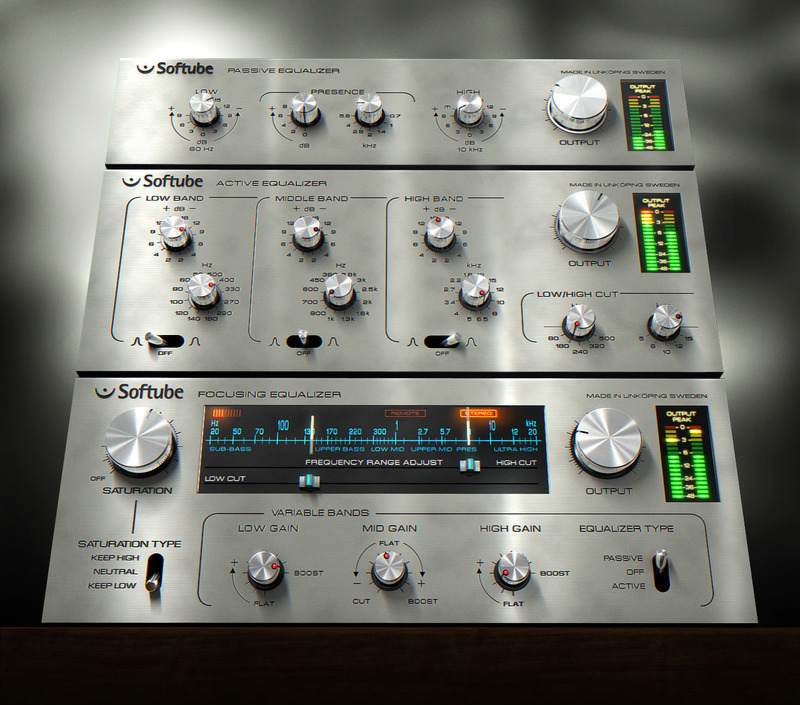
The Passive-Active Pack is a collection of three very different equalizers, each with its own character and quirks. The Passive and Active equalizers emulate real workhorse units, used on thousands of recordings from past to present. The Focusing Equalizer combines these with analog sounding saturation and a novel workflow.
Passive Equalizer

Passive Equalizer is modeled from a famous German passive three-band equalizer, and features a wide bandwidth and an unsurpassed clear and open sound. The low boost gives you a warm low end, perfect to fatten up a bass drum or bass guitar track. Cutting the highs gives you a very gentle 6 dB cut which allows you to remove highs in a very musical way. The high boost is open and crisp and breathes life into any track.
Key Features:
- Three bands with an extremely wide and open sound
- Excellent treble control without any "digital harshness"
- Warm low end and a sparkling top
Active Equalizer

Active Equalizer is modeled from an active equalizer design made somewhere in the Swiss alps in the seventies. Whereas the Passive Equalizer is wide, clear and unintrusive, the Active Equalizer is more of a surgeon with a tight and focused sound. It's a highly useful problem solver when you need to get into details.
Key Features:
- Tight and focused sounding filters
- Low and High cut
- Three parametric bands with selectable gain in 2dB steps (-/+ 16 dB), selectable frequency with overlapping, but non-interfering, bands (50-500 Hz, 380Hz-3.8kHz, 1.8-18kHz) and a choice between a narrow or wide peak (Q) for each band
Focusing Equalizer

Focusing Equalizer is an inspiring and untraditional take on the EQ concept, which is all made up by Softube. The Focusing Equalizer works in a very musical way and does a lot of thinking for you.
At first glance it may seem like you're sacrificing versatility by using an equalizer with a limited set of options - why use a three-band equalizer when you can use your digital equalizer with umpteen bands, continous gain, selectable Q and different curves all built in? Well, equalization is all about sound design. Having an equalizer where the designer has already made some of the choices four you is like having an experienced sound engineer helping out and giving you directions.
Key Features:
- Inspiring, untraditional and very useful workflow
- Choose between Passive or Active EQ character
- Three-band EQ that automatically and musically changes with Low and High Cut
- Built-in one-knob saturation with metering and selectable saturation type
Video
Rating
- Mac OS X 10.13 or newer (older OS versions will not work) (64-bit only).
- Windows 10 64-bit (older Windows versions may work but are not tested) (64-bit only).
- Mac: Intel Core i3 / i5 / i7 / Xeon - M1 support pending.
- Windows: Intel Core i3 / i5 / i7 / Xeon / AMD Quad-Core or newer.
- Screen resolution 1280x800 or larger.
- Supported sample rates: 44.1, 48, 88.2, 96, 176.4 and 192 kHz, in both mono and stereo.
- 8 GB RAM or more is recommended, as well as at least 8 GB hard disk space for installation (individual plug-ins take less space, while sample libraries may require additional disk space).
- A Softube account is required to register and install the software.
- An iLok account is required for authorisation of the software.
- Internet access for downloading installer and managing licenses.
- iLok generation 2 and up, if you intend to use a physical iLok dongle for authorizing your plug-ins (note that an iLok dongle is not a requirement).
- In theory, any 64-bit VST, VST3, AU, or AAX (11.0.2 or higher) compatible host application should work.
- The most recent maintenance release of the DAW application is recommended.
However, due to plug-in host differences between DAWs - and Softube's own rigorous testing standards - Softube only officially test their plug-ins and instruments in the most recent versions of Pro Tools, Logic Pro, Cubase, Live, Studio One, Digital Performer, Reaper and Sonar. Softube plugins are not tested in the non-listed systems, but they most likely work as long as the system requirements are met.
Important note: make sure that you always use the latest iLok License Manager. It is not included in the Softube installer but can be downloaded from www.ilok.com
The Hoser XT
EQ by Boz Digital Labs
Images
Description
When you buy Hoser XT, you get its little brother, The Hoser, for free
The second in the series of David Bendeth signature plugins. Modeled off of a Ward-Beck Systems M462B hardware EQ unit, The Hoser makes a great channel channel EQ to give that cohesive feel to your mixes.
The Hoser takes advantage of some of the benefits of working in the digital domain, all while staying true to the analog sound. It is really the best of both worlds.
When you buy Hoser XT, you get its little brother, The Hoser, for free.
Analog Sound – CPU Friendly
When we built The Hoser, we had two objectives:
- It must sound just like the hardware
- You should be able to use this plugin on every track without worrying about your CPU overheating.
After much trial and error, we finally accomplished this. The plugin stays true to the analog sound, allowing you to add extreme amounts of gain without adding the harshness of digital EQ. It does all this while using small amounts of processing power, to preserve your CPU for other plugins. It’s really the best of both worlds.
3 Channel Modes
While we were using the hardware, we couldn’t help but wish that we could use it in a mid/side configuration. It was just begging for it. So what was stopping us from making the plugin work in mid/side mode? Nothing, that’s what.
You can also process your left and right channels separately, which is a great way to add some stereo width to a mono track, or match the tone of a stereo source.
The Hoser vs The Hoser XT
When you buy The Hoser XT, The Hoser also comes with your download, but what is the difference?
The Hoxer XT
- Separate Mid/Side and stereo control, as well as standard stereo/mono mode
- Comes with The Hoser
The Hoser
- More compact design
- stereo/mono mode only
Video
Rating
Available Formats:
- Windows (32/64): VST2, VST3, RTAS, AAX Native
- Mac (32/64): AU, VST2, VST3, RTAS, AAX Native
When you buy Hoser XT, you get its little brother, The Hoser, for free
The second in the series of David Bendeth signature plugins. Modeled off of a Ward-Beck Systems M462B hardware EQ unit, The Hoser makes a great channel channel EQ to give that cohesive feel to your mixes.
The Hoser takes advantage of some of the benefits of working in the digital domain, all while staying true to the analog sound. It is really the best of both worlds.
When you buy Hoser XT, you get its little brother, The Hoser, for free.
Analog Sound – CPU Friendly
When we built The Hoser, we had two objectives:
- It must sound just like the hardware
- You should be able to use this plugin on every track without worrying about your CPU overheating.
After much trial and error, we finally accomplished this. The plugin stays true to the analog sound, allowing you to add extreme amounts of gain without adding the harshness of digital EQ. It does all this while using small amounts of processing power, to preserve your CPU for other plugins. It’s really the best of both worlds.
3 Channel Modes
While we were using the hardware, we couldn’t help but wish that we could use it in a mid/side configuration. It was just begging for it. So what was stopping us from making the plugin work in mid/side mode? Nothing, that’s what.
You can also process your left and right channels separately, which is a great way to add some stereo width to a mono track, or match the tone of a stereo source.
The Hoser vs The Hoser XT
When you buy The Hoser XT, The Hoser also comes with your download, but what is the difference?
The Hoxer XT
- Separate Mid/Side and stereo control, as well as standard stereo/mono mode
- Comes with The Hoser
The Hoser
- More compact design
- stereo/mono mode only
Video
Rating
Available Formats:
- Windows (32/64): VST2, VST3, RTAS, AAX Native
- Mac (32/64): AU, VST2, VST3, RTAS, AAX Native
SEQ-ST
EQ by NUGEN Audio
Images
Description
Powerful Sonic Sculpting
SEQ-ST delivers sculpting power beyond any other EQ. The resizable direct-draw interface makes it easy to quickly fine-tune your audio, with incredible resolution that you can’t get with a traditional parametric interface. SEQ-ST gives you complete control over your spatial environment, with access to stereo & mid/side operation.
Unparalleled Flexibility
- Linear phase spline EQ
- Curve scaling and smoothing
- Zoomable and resizable interface
- No phase smearing
- Frequency node locking
- Psychoacoustic banding
- Match EQ presets
Intuitive EQ Matching
Use SEQ-ST to capture the flavour of a piece of source audio and match it to your current work – great as a reference for mastering. Or use this match technique on individual tracks to unify different takes, microphone positions, and more.
Plus, by inverting the match EQ curve, you can achieve a minimally invasive technique for carving out space in a complex mix where traditional EQs won’t cut it.
For Music Production
Fine-tune and correct your sound with flexible, detailed envelopes difficult to achieve with a traditional parametric EQ. Plus, take advantage of independent left/right and mid/side operation, even within the same plug-in instance.
Use EQ matching to gently push your sound toward reference material or dive into new creative spheres with tempo locked effects. Ideal for both corrective mix work and gentle mastering polish.
For Post and Broadcast
Precise corrections which would be very time consuming with a traditional parametric interface are a breeze with SEQ-ST’s flexible nodes and direct draw interface.
Match 'invert' makes it quick and easy to find space for dialogue in a busy soundtrack, avoiding heavy-handed EQ or intrusive ducking.
Typical Applications
- Independent control of left/right & mid/side channels
- EQ matching
- Creating 'perfect space' for vocals or dialogue
- Mono and stereo audio production
Rating
Mac
- Mac OSX 10.9 and above
- 512 MB RAM
- 64-bit only
- Available in 64-bit AAX, VST3, AU & AudioSuite Formats
Windows
- Windows Vista and above
- 512 MB RAM
- 64-bit only
- Available in 64-bit AAX, VST3 & AudioSuite Formats
Powerful Sonic Sculpting
SEQ-ST delivers sculpting power beyond any other EQ. The resizable direct-draw interface makes it easy to quickly fine-tune your audio, with incredible resolution that you can’t get with a traditional parametric interface. SEQ-ST gives you complete control over your spatial environment, with access to stereo & mid/side operation.
Unparalleled Flexibility
- Linear phase spline EQ
- Curve scaling and smoothing
- Zoomable and resizable interface
- No phase smearing
- Frequency node locking
- Psychoacoustic banding
- Match EQ presets
Intuitive EQ Matching
Use SEQ-ST to capture the flavour of a piece of source audio and match it to your current work – great as a reference for mastering. Or use this match technique on individual tracks to unify different takes, microphone positions, and more.
Plus, by inverting the match EQ curve, you can achieve a minimally invasive technique for carving out space in a complex mix where traditional EQs won’t cut it.
For Music Production
Fine-tune and correct your sound with flexible, detailed envelopes difficult to achieve with a traditional parametric EQ. Plus, take advantage of independent left/right and mid/side operation, even within the same plug-in instance.
Use EQ matching to gently push your sound toward reference material or dive into new creative spheres with tempo locked effects. Ideal for both corrective mix work and gentle mastering polish.
For Post and Broadcast
Precise corrections which would be very time consuming with a traditional parametric interface are a breeze with SEQ-ST’s flexible nodes and direct draw interface.
Match 'invert' makes it quick and easy to find space for dialogue in a busy soundtrack, avoiding heavy-handed EQ or intrusive ducking.
Typical Applications
- Independent control of left/right & mid/side channels
- EQ matching
- Creating 'perfect space' for vocals or dialogue
- Mono and stereo audio production
Rating
Mac
- Mac OSX 10.9 and above
- 512 MB RAM
- 64-bit only
- Available in 64-bit AAX, VST3, AU & AudioSuite Formats
Windows
- Windows Vista and above
- 512 MB RAM
- 64-bit only
- Available in 64-bit AAX, VST3 & AudioSuite Formats
Claro
EQ by Sonnox
Images
Description
Whether you're a bedroom producer or a Grammy-winning pro, you want to take control to develop your own musical voice. Claro will empower you to make informed musical decisions in a unique and intuitive way.
Claro is a comprehensive EQ Plug-In that serves the production process from composition to final mix, with three distinct views, progressively adding deeper insight and precision to prevent mud, clutter, or harshness, helping you blend your tracks into a clear and balanced mix.
How does Claro benefit you?
Staying focused is difficult, it slows the production process and kills creativity.
Specifically designed to offer "Vibe first, detail later", Claro has three distinct views which help to build your EQ intuition and confidence without interrupting the flow. You'll be guided towards making the right decision for you, first time, every time.
After having reduced masking from your previously muddy mix, have you ended up with something lifeless or sterile?
Of course, you have, but were you aware that not all masking is bad all of the time? Masking can impart body, thickness and presence to your tracks. Claro identifies masking and empowers you to learn and choose whether it is problematic or positively contributing to the tone you're trying to achieve.
Resonance isn't always bad.
Resonances are the sharp, tonal characteristics that ring over time, as the overtones of a bell. They can cause things to sound harsh or boxy, and while you might be tempted to notch out or remove all of the resonances, they also help determine that sound's character, including its pitch.
When searching for resonant areas to tweak, Claro shows precise peaks and highlights those that resonate most over time.
You don't always refer to audio in specific Hz, so why should your Plugin?
Claro's friendly, intuitive interface guides you towards frequency ranges using familiar words such as 'Mud' and 'Harshness' in addition to Hz. A piano keyboard is also displayed to set your EQ band to a specific note helping you to work musically.
Produce | Tweak | Mix
Three Distinct Views
Claro sustains focus and accelerates your workflow through three distinct views.
The first is the PRODUCE view, offering a fast, creative EQ that actively promotes your musical creativity while removing unnecessary distractions and complex technical terminology.
TWEAK view then opens up more correctional possibilities, providing you with the cleanest, most flexible filters. The real-time analyser adapts to your moves and helps to identify problematic resonances.
Finally, use the MIX view to understand and assemble your mix. Every track is simultaneously displayed for you to prioritise, explore interactions and swiftly address frequency collisions between competing tracks.
Claro is an equaliser that aids the production process from composition to final mix. Progressively adding deeper insight and precision, Claro maintains focus and accelerates your workflow through three distinct views.
Produce - Tone
![]()
Build EQ intuition and confidence without interrupting your flow.
Broad EQ moves while creating, even if they're subtle, often inspire you to make different musical decisions.
Focus on where the energy is and discover what tonal characteristics you want to achieve.
Produce - Width
![]()
Mid-side EQ is often essential for cleaning up stereo synths and loops or creating space for vocals, and it's just as quick as Tone shaping.
Flip to Width mode to see the side-channel energy and tweak it.
Too much rumble in the sides? Mono the bass with the Low Cut Filter.
Tweak
![]()
Sometimes you'll need to dive into finer details, tweak filter resonance, adjust left/right and mid/side balance, or attenuate areas that contribute to boxiness or harshness.
Claro's adaptive spectrum analyser follows the channel (stereo, left/right or mid/side) and the Q of the band you're adjusting to show you what you need to see.
No more boosting and sweeping. Claro identifies resonances and highlights them so you can be in control of how much or little you wish to attenuate those resonances.
Mix
![]()
View all Claro instances across your project and see how the audio interacts.
Drag & drop tracks to explore corrective EQ moves across any combination of tracks from the same window.
Yellow highlights indicate where each track in your mix competes against, or masks, your chosen reference track. Areas of masking can lead to it sounding boomy, muddy, or harsh.
Use the Invert EQ function to apply corresponding boosts to one track and cuts to another to reduce masking and give each track its own spectral space.
Video
Rating
The Toolbox range offers 2 activations for each product licence you buy.
Providing you have an iLok account, each activation will allow you to authorise your plugin on one of these devices:
- Machine
- iLok device, iLok2 / iLok3 required with latest drivers
- iLok Cloud (Active internet connection required)
Pro Tools AAX
- Pro Tools 11 and above – AAX Native
- Approved Pro Tools CPU, OS and hardware configuration
Audio Units
- Audio Units (AU) compatible application (Logic, Digital Performer etc.)
- Mac OS X 10.8 or later
VST3
- VST3 compatible application (Cubase, Nuendo, Studio One etc.)
- Mac OS X 10.8 or later
- Windows 7 or later
Supported Hosts:
- Compatible with any desktop application that supports Audio Unit (AU), VST3 or Pro Tools AAX Native plugins.
Please Note: This product supports iLok Cloud Authorisation. An iLok USB Dongle OR an active internet connection is required in order to activate and use this product.
Whether you're a bedroom producer or a Grammy-winning pro, you want to take control to develop your own musical voice. Claro will empower you to make informed musical decisions in a unique and intuitive way.
Claro is a comprehensive EQ Plug-In that serves the production process from composition to final mix, with three distinct views, progressively adding deeper insight and precision to prevent mud, clutter, or harshness, helping you blend your tracks into a clear and balanced mix.
How does Claro benefit you?
Staying focused is difficult, it slows the production process and kills creativity.
Specifically designed to offer "Vibe first, detail later", Claro has three distinct views which help to build your EQ intuition and confidence without interrupting the flow. You'll be guided towards making the right decision for you, first time, every time.
After having reduced masking from your previously muddy mix, have you ended up with something lifeless or sterile?
Of course, you have, but were you aware that not all masking is bad all of the time? Masking can impart body, thickness and presence to your tracks. Claro identifies masking and empowers you to learn and choose whether it is problematic or positively contributing to the tone you're trying to achieve.
Resonance isn't always bad.
Resonances are the sharp, tonal characteristics that ring over time, as the overtones of a bell. They can cause things to sound harsh or boxy, and while you might be tempted to notch out or remove all of the resonances, they also help determine that sound's character, including its pitch.
When searching for resonant areas to tweak, Claro shows precise peaks and highlights those that resonate most over time.
You don't always refer to audio in specific Hz, so why should your Plugin?
Claro's friendly, intuitive interface guides you towards frequency ranges using familiar words such as 'Mud' and 'Harshness' in addition to Hz. A piano keyboard is also displayed to set your EQ band to a specific note helping you to work musically.
Produce | Tweak | Mix
Three Distinct Views
Claro sustains focus and accelerates your workflow through three distinct views.
The first is the PRODUCE view, offering a fast, creative EQ that actively promotes your musical creativity while removing unnecessary distractions and complex technical terminology.
TWEAK view then opens up more correctional possibilities, providing you with the cleanest, most flexible filters. The real-time analyser adapts to your moves and helps to identify problematic resonances.
Finally, use the MIX view to understand and assemble your mix. Every track is simultaneously displayed for you to prioritise, explore interactions and swiftly address frequency collisions between competing tracks.
Claro is an equaliser that aids the production process from composition to final mix. Progressively adding deeper insight and precision, Claro maintains focus and accelerates your workflow through three distinct views.
Produce - Tone
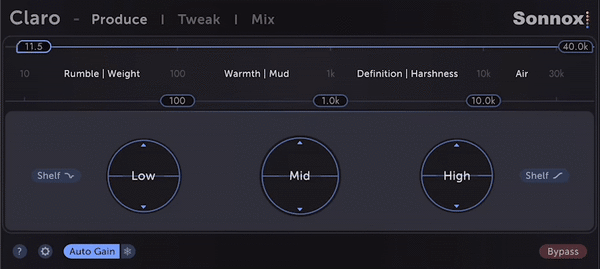
Build EQ intuition and confidence without interrupting your flow.
Broad EQ moves while creating, even if they're subtle, often inspire you to make different musical decisions.
Focus on where the energy is and discover what tonal characteristics you want to achieve.
Produce - Width
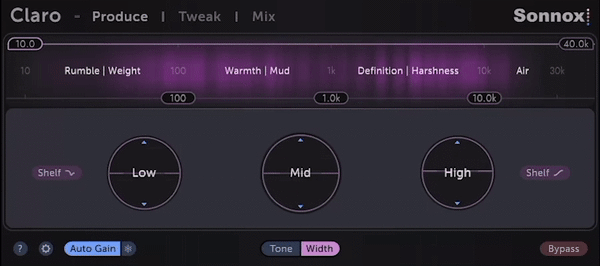
Mid-side EQ is often essential for cleaning up stereo synths and loops or creating space for vocals, and it's just as quick as Tone shaping.
Flip to Width mode to see the side-channel energy and tweak it.
Too much rumble in the sides? Mono the bass with the Low Cut Filter.
Tweak
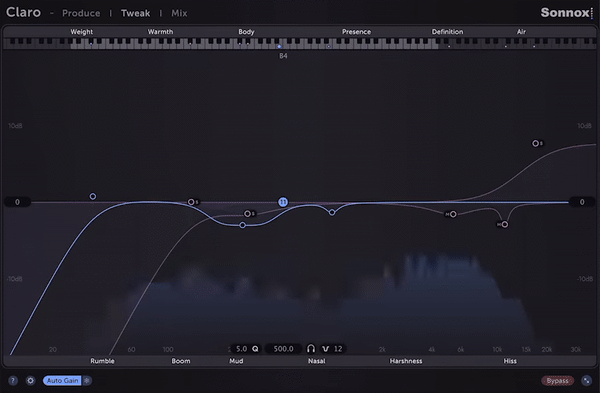
Sometimes you'll need to dive into finer details, tweak filter resonance, adjust left/right and mid/side balance, or attenuate areas that contribute to boxiness or harshness.
Claro's adaptive spectrum analyser follows the channel (stereo, left/right or mid/side) and the Q of the band you're adjusting to show you what you need to see.
No more boosting and sweeping. Claro identifies resonances and highlights them so you can be in control of how much or little you wish to attenuate those resonances.
Mix
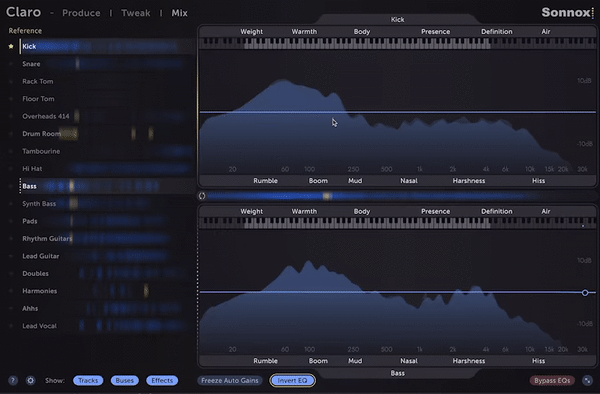
View all Claro instances across your project and see how the audio interacts.
Drag & drop tracks to explore corrective EQ moves across any combination of tracks from the same window.
Yellow highlights indicate where each track in your mix competes against, or masks, your chosen reference track. Areas of masking can lead to it sounding boomy, muddy, or harsh.
Use the Invert EQ function to apply corresponding boosts to one track and cuts to another to reduce masking and give each track its own spectral space.
Video
Rating
The Toolbox range offers 2 activations for each product licence you buy.
Providing you have an iLok account, each activation will allow you to authorise your plugin on one of these devices:
- Machine
- iLok device, iLok2 / iLok3 required with latest drivers
- iLok Cloud (Active internet connection required)
Pro Tools AAX
- Pro Tools 11 and above – AAX Native
- Approved Pro Tools CPU, OS and hardware configuration
Audio Units
- Audio Units (AU) compatible application (Logic, Digital Performer etc.)
- Mac OS X 10.8 or later
VST3
- VST3 compatible application (Cubase, Nuendo, Studio One etc.)
- Mac OS X 10.8 or later
- Windows 7 or later
Supported Hosts:
- Compatible with any desktop application that supports Audio Unit (AU), VST3 or Pro Tools AAX Native plugins.
Please Note: This product supports iLok Cloud Authorisation. An iLok USB Dongle OR an active internet connection is required in order to activate and use this product.
